
10 top wild swimming spots with Wild Swimming Cornwall


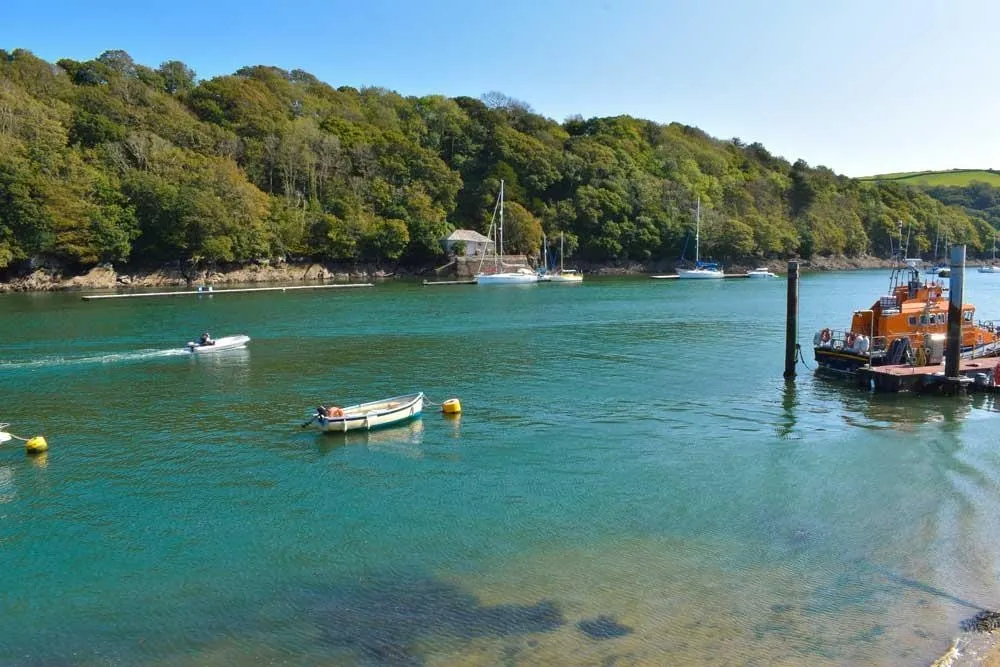
The evenings are lighter and the weather is getting warmer. Sunnier days are the perfect opportunity to explore more of Cornwall via the sea.
Paddleboarding is the dream spring and summer activity – it’s slow and laid back, allowing you to soak up the scenery as you glide down calm estuaries, but still provides a challenge in balance when you go to stand up!
Once you’ve mastered this relaxing watersport, all you need to do is hire a board and get out on the water. Here’s our run down of the best (and lesser known) spots for paddleboarding around Cornwall this year.
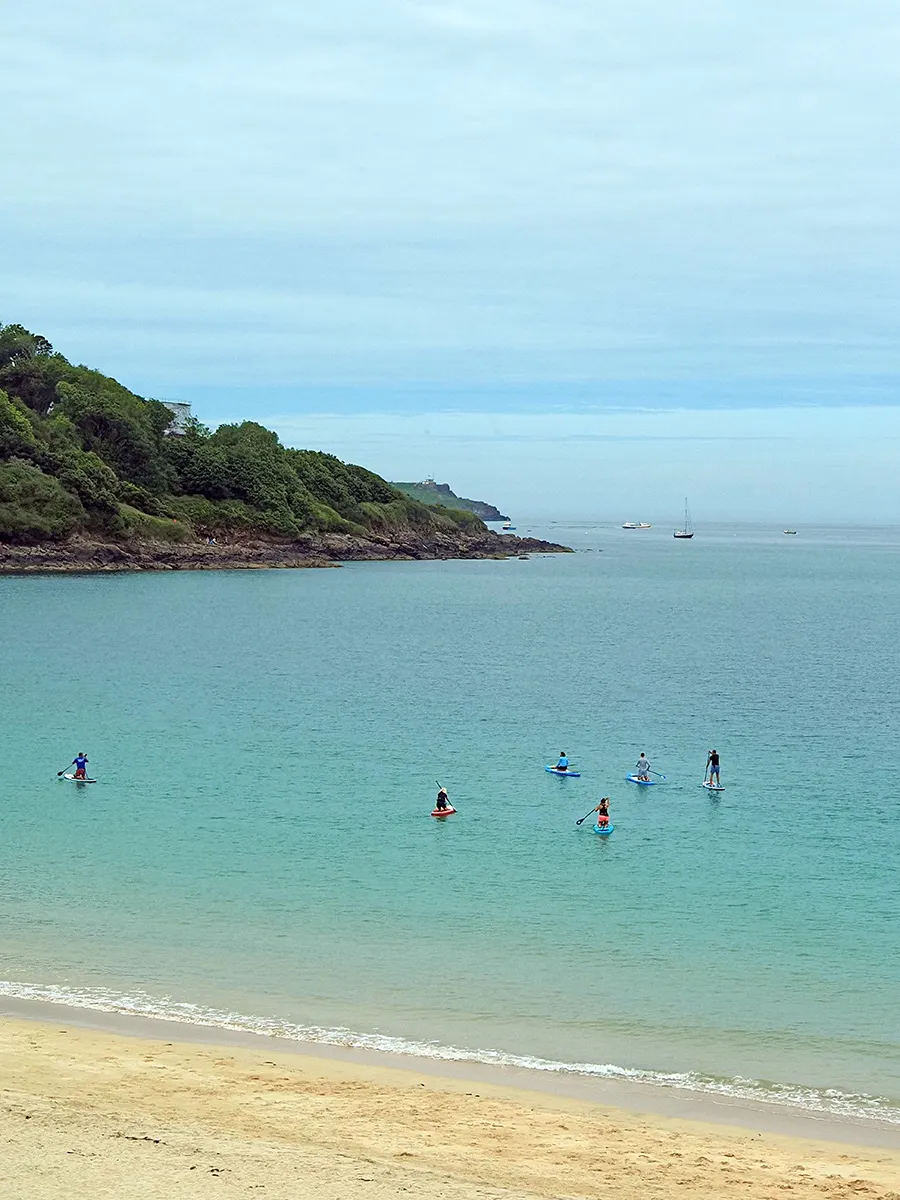
Paddleboarding Carbis Bay. Credit: Hayley Lawrence
This pretty fishing village sits around a beautiful estuary which attracts kayakers and swimmers alongside stand up paddleboarders all year round. Before or after your paddleboard, grab a drink from one of the riverside bars and cafes and soak up the bustling, cheery atmosphere of this happy town.
Discover coastal charm at Fowey, South Cornwall, with Beach Retreats.

This beautiful tree lined creek offers a lovely quiet spot for a paddleboard. With clear water and an abundance of wildlife living along the shores, the Helford River is great for nature lovers or anyone looking to get away from the summer crowds. Reach Helford just a short drive from our Falmouth retreats.
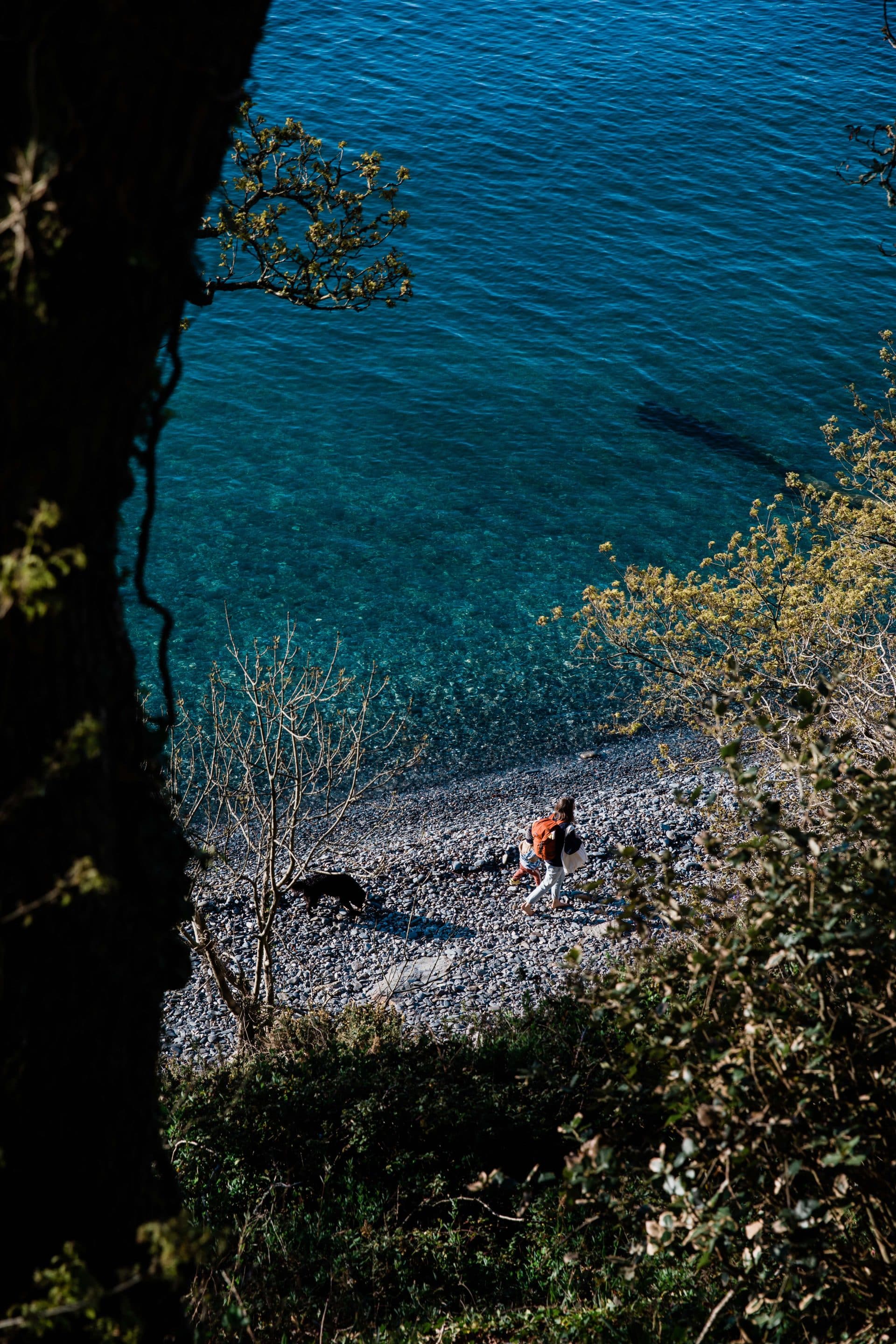
At low tide, you’ll find a bank of ridged sand, but at high tide, this tidal river fills with turquoise water perfect for paddleboarding. With plenty of paths from Newquay and Fistral beach leading to the Gannel, there’s many easy access launch points. Glide past tropical plants and higgeldy gardens towards Crantock beach, taking in the sight of wild sea birds as you go.
Browse our retreats near the River Gannel, including Heron House which features a gate at the bottom of the garden which leads directly onto the river bank.
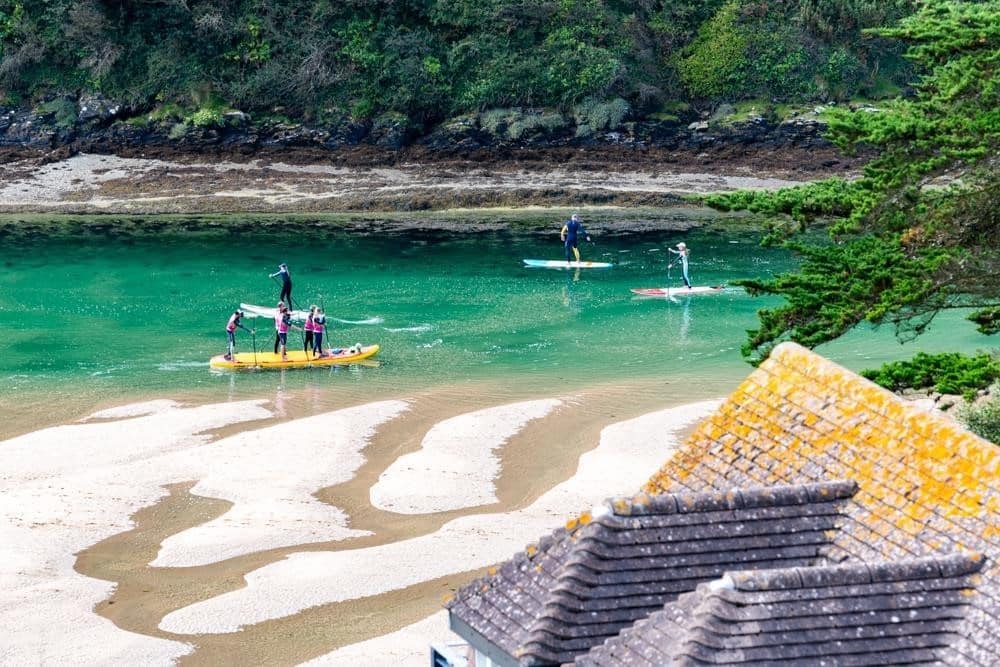
With beautifully calm seas, these south coast beaches are perfect for idyllic paddleboarding days out on the water. Sitting next to one another, you can enjoy a relaxing stroll around the villages and a coffee from the beachfront café before floating out onto the crystal clear shores.
Our Cawsand retreats are literally seconds from the sand, too, making paddleboarding sessions easy.
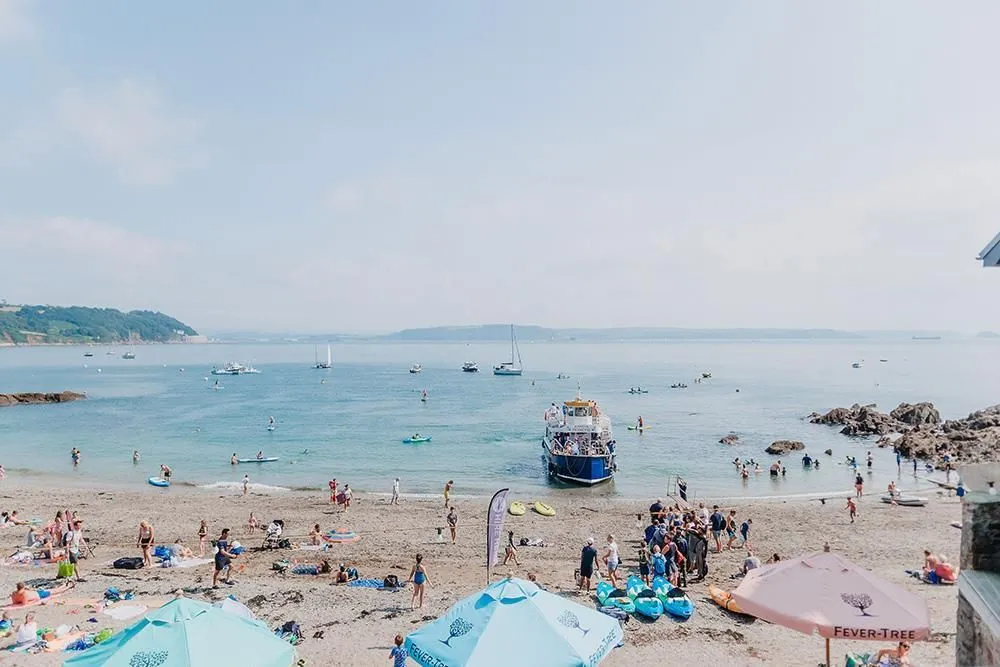
This bright blue estuary lies between Padstow and Rock, and on a summer’s day you’ll see regular boat trips, ferries and water taxis crossing the water, alongside paddleboarders and kayakers enjoying the flat conditions. With both Padstow and Rock great foodie destinations, whichever side you set off from you’ll have plenty of delicious options to refuel once you dock.
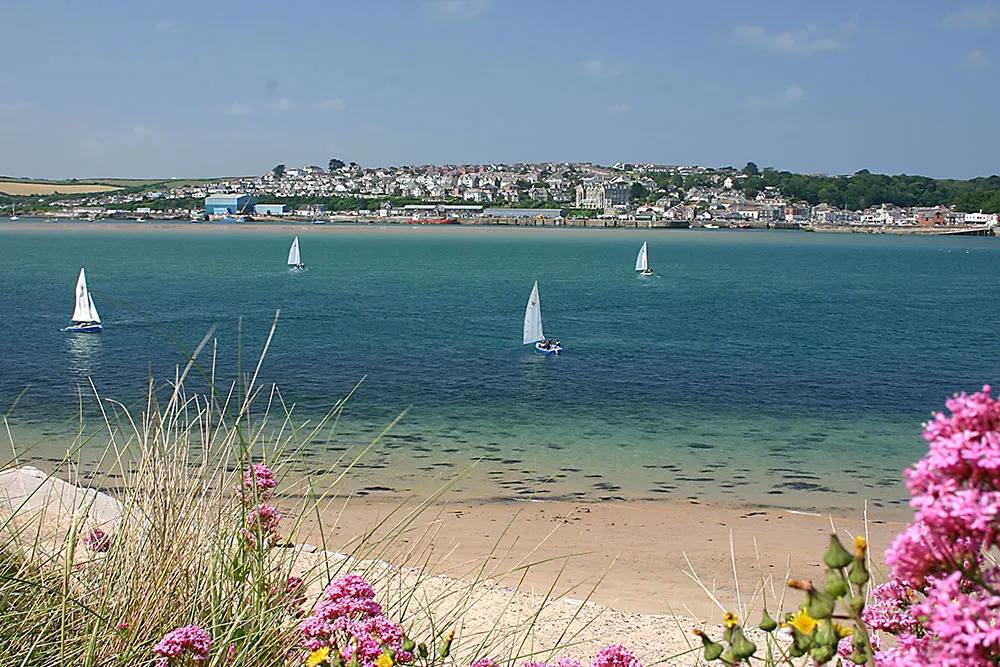
Find your next holiday location and enjoy days drifting along the water.
Dive into the exciting world of alternative surf activities in Cornwall and discover new ways to enjoy the waves
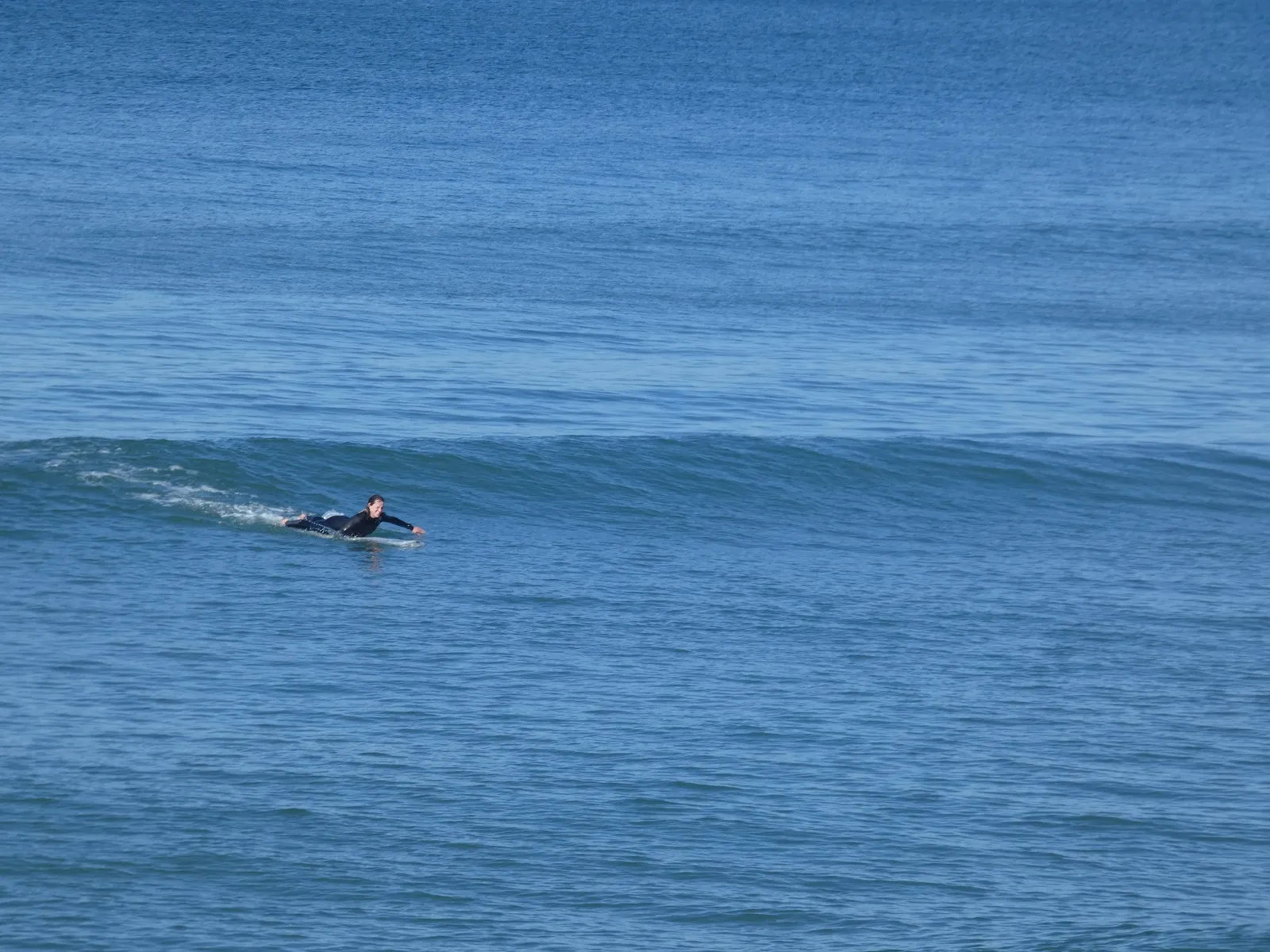
From the far west to the overlooked south east, via the unmatched north, there’s a bay and a board for everyone. Keen board riders and paddlers reveal their chosen craft and coast…
Cornwall’s winding coastline reveals countless unmissable stops for enjoying and exploring the sea by board. Samantha Bruce and Georgia O’Carolan of Whitsand Bay Ladies Surf Club, Matt Hawken at Newquay Activity Centre, and Dan Bassett at Surf St Ives tell us which board they reach for and where they’re heading…
Stay seconds from the surf with our Wave-Seekers Edit: retreats 400 metres or less to a great surfing beach.
Organised by the Adventure Bay Surf School, Whitsand Bay Ladies Surf Club was Georgia O’Carolan’s first surf experience. “Outrageously, I didn’t start any board sports in the water until joining the Club when I was 27 because I thought I was too old to learn, which I now think at nearly 30 is just beyond silly.
“We have all ages, sizes and abilities in our club and it doesn’t matter how good you are, as long as you’re safe – which might mean a lesson or a lifeguarded beach – you belong there in the sea. My tip for a novice would be to just go out and do it!”

Image credit: Adventure Bay Surf School
Georgia – RNLI lifeguard – says her corner of Cornwall on the south east coast is a little quieter which can mean more choice and opportunities to catch waves out in the bay. “Our swells might not come in as big and fierce as the north coast generally, but we’re a great surf destination when it’s in, and great for beginners and intermediates.”
And when she is paddling out at Whitsand she opts for a Mick Fanning Sugar Glider, either 7ft 6in or 7ft. “It’s fast and fun, and the first time apart from a rescue board, I’ve used a single-fin board.”
Fancy staying in Whitsand Bay? Have a look at our Whitsand Bay holiday properties.
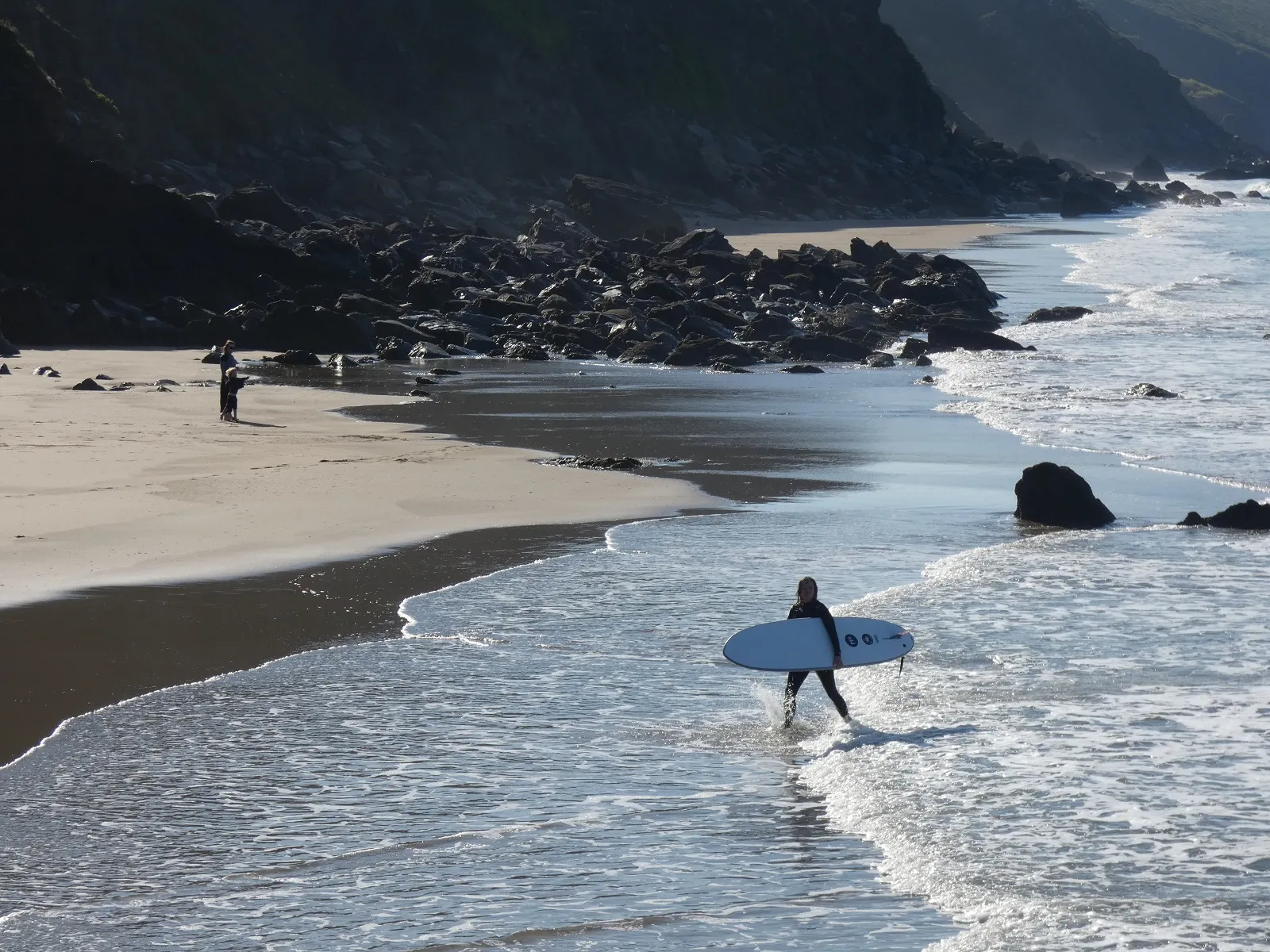
Image credit: Adventure Bay Surf School
Fellow Ladies Club member Samantha Bruce goes for the KORE 7ft 2 Fun board when she’s catching waves at Tregonhawke or northwards at Bude.
What makes a great surfing beach? “A long sandy beach, with minimal rocks, a short approach – so I’m not carrying my board for miles – and even better if there’s a coffee van or food shack for a refuel and hang after,” says Samantha.
Her preferred conditions are 3-4ft, slightly wild waves. “I enjoy the challenging conditions and having a laugh with the girls while navigating them,” she adds.
For first timers, Samantha recommends a small group or 1:1 lesson. “Speaking as someone who wanted to surf for years but was apprehensive, you’ll know instantly if it’s for you, then find a group to be part of.”
“It’s beautiful and so peaceful – teaming with wildlife and amazing views. It can be difficult to find a good launch spot, if you don’t know the area, and it’s definitely worth knowing your tides, but it’s one of the best spots to paddleboard on the north coast.”
Matt Hawken, paddleboard instructor at Newquay Activity Centre, is talking about the River Gannel which meets the sea at Newquay. Staying with the whole family or all your best friends, everyone can enjoy stand-up paddleboarding along the Gannel.
“Because it’s so sheltered, it’s an awesome spot for all skill levels,” says Matt. “With the right tide and the best spots, the water barely moves and it’s great for enhancing your skills.”
Waterborne explorers can venture upriver to Trevemper or downriver to Crantock Beach, with a guided tour the best way to find the ideal launch spots and tidal conditions. A calm, laidback board choice, paddleboarding reveals views and coastline locations hidden when exploring on land.
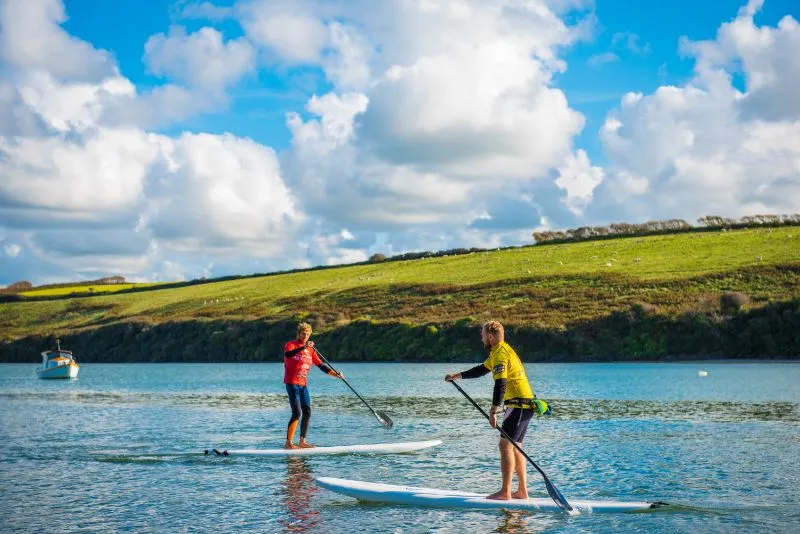
Image credit: Newquay Activity Centre
As well as floating down isolated creeks along the Gannel, Matt recommends the expanse of Newquay Bay on a calm summer’s day. “It’s surprisingly sheltered for the north coast of Cornwall. At about mid-tide you can dot in and around Little Lusty through the rocks, and there’s even a secret cave to paddle through. And then down to Porth beach for a quick break and back towards the harbour. The water is crystal clear, the sun is shining, there might even be seals and dolphins enroute.”
Surf St Ives’ Daniel Bassett chooses an Alaia, a fin-less style of wooden surfboard originating from Hawaii, for his board-based excursions.
Wooden surfboard crafters, Otter Surfboards, describe the Alaia as “a thin, narrow, solid wood surfboard with a round nose and square tail and, most importantly, no fins. They originated in pre-contact Hawaii where they were shaped from Koa wood left over from producing canoes and they were usually around 7-12 feet long. Modern Alaias usually come up between 5 and 8 feet long.”
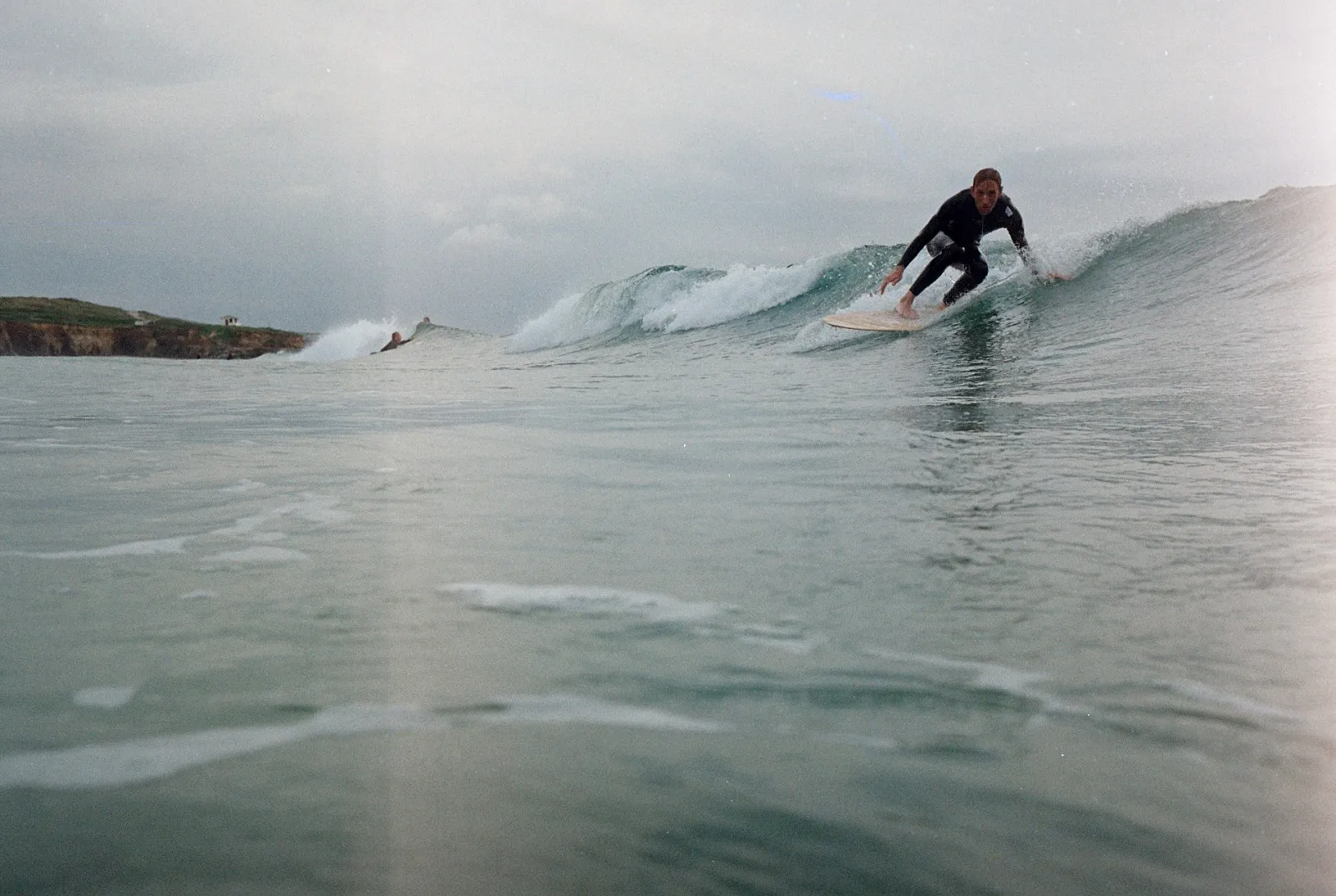
Image credit: Daniel Bassett @surfstives
Daniel says he likes to be out on the Alaia at Godrevy, near Hayle, but is happy catching a wave along the coast as long as it is breaking on his left side as he glides towards the sand, known simply as a left.
Spacious beaches and September swells are the best conditions for Daniel who surfs to “escape the worries of everyday life and be at one with the elements.”
“I’d recommend spending time on a bellyboard for learning how to read the ocean and feel comfortable in the water, before progressing to surf-craft,” he says.
All along the coast, wooden bellyboards can be hired for free thanks to Surf Wood for Good. A bellyboard for acclimatising to the waves can be picked up for the day from just inland of St Ives Surf School at Little Goat Gruff. And there’s more than 10 locations across Cornwall to pick-up a borrowed bellyboard for wave-seeking elsewhere.
Read our blog on the best things to do in the sea in every season.
A secluded stay for two or a celebration pad for everyone, choose where you’ll stay for your chosen board time…
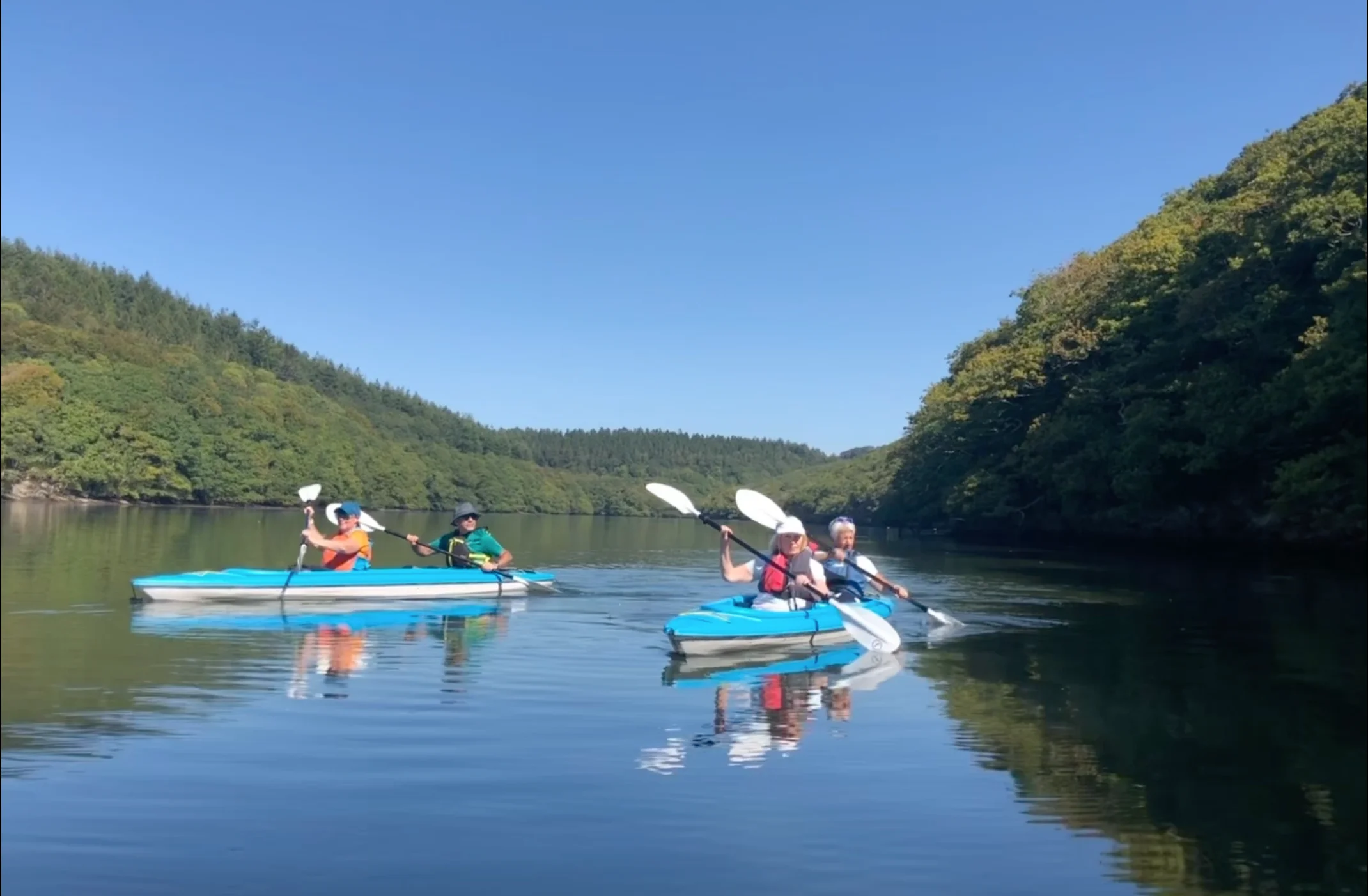

Sleeping by the sea means catching a wave at any time when conditions allow, early, late or later still. This is the #beachoutofhours. But before pulling on your wetsuit and reaching for your board, take a few moments to read the surf…
Such is the whimsy of the British weather that you never quite know what to expect when you peel back the curtains from the cosy embrace of your seaside bed. While a day lounging on the beach with a well-thumbed paperback fares better when the sun is sparkling, the sea’s there to be enjoyed come rain or shine.
Want to stay in a luxury holiday house with a view of the sea? Check out our cottages with sea views.
In fact, when it comes to surfing, a touch of mizzle can actually improve conditions, says Charlie Unsworth, who works as an instructor at Croyde Surf Academy in North Devon.
“The rain can actually help the surf as it ‘grooms’ the waves,” he says. “It can patten them down into a smooth state, making it a nice clean ride. You’re wet already, so a little bit of rain doesn’t hurt.”
Check out our other locations and retreats across North Cornwall.
Before you spring into your neoprene, however, spend a few moments casting your eye over the horizon to gauge the state of the waves.

Catching a wave in Croyde Bay
Image credit: Lou Pamment @lou.lives.big
“Ideally, you want a unified wave – so one straight line, not little waves coming in from all angles. That tells you the surf is clean and going to be easier to surf.”
When it comes to wind, preferably you want it to be offshore, delaying the break of the wave and keeping it glassy. Charlie says: “Look for a steady blowing wind, ideally not over 15mph, otherwise you end up battling the wind and weather rather than surfing.”
Tim Heyland has been surfing the beaches of Cornwall and Devon for over 50 years. For surfing novices, he recommends getting up early and keeping an eye on the traffic.
“A cheat’s way to read the surf is to look at the number of boards heading to the beach. If you see the car park filling up with surfers, you’ll know there’s going to be good waves.
“Another tip is to have your surf early in the morning, as there’s very little wind first thing. As the land heats up during the day, the wind generally picks up. It then falls away again in the evening, so before sunset is another good time to get in the water.”
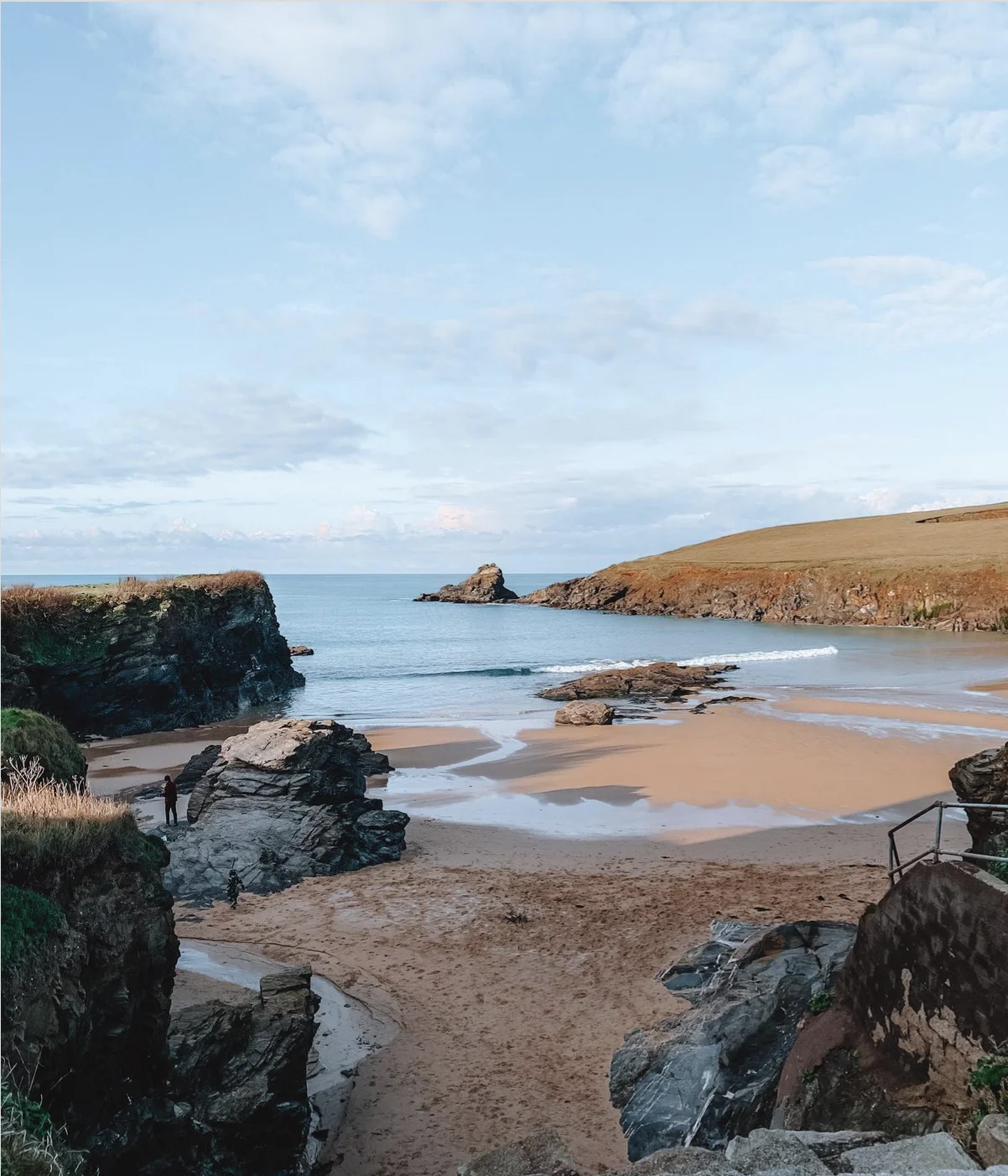
Trevone Bay at low tide
Image credit @steph__andr
For people with disabilities, there’s more than just the weather and the groundswell to take into consideration.
“My advice would be to go in the sea just before high tide,” says adaptive surfer and open water swimmer Issy Kingdon, who surfs with The Wave Project. “You’ll have less distance to travel across the sand and you can enjoy it for a good half hour before the tide starts to recede again.”
While beach wheelchairs are available, they tend to book up quickly during the high season. Issy therefore recommends looking for beaches with slipway access to the sea. “Trevone Bay near Padstow is a good example of an accessible beach as you can drive right down and get directly into the sea at high tide” she says.
Discover six stunning spots to watch the sunrise in Cornwall, each offering panoramic views and unforgettable moments along the coast.
“Obviously a calm day is preferable but those are never guaranteed. Last summer I’d just got in the water at Trevone when a freak hailstorm hit. It was wild but also hilarious. As long as it’s safe, you’ve got to make the most of it!”
On RNLI beaches, surfing zones are marked out with the black and white flags, helping surfers know where to paddle out and letting you know that lifeguards are on hand to answer questions and help when needed.
If you can’t see the surf there and then, apps such as Surfline and Windy provide up to date reports, including information on surf height, swell, wind direction, wind speed and tide times.
While the data is usually pretty accurate, it pays not to be too reliant on technology.
“Nothing beats going to the beach to look at the conditions for yourself,” says Tim. “An app might say the surf is ‘poor’, but you can still have fun on little waves. Or, if it really is all over the place, swap your surfboard for a bellyboard and have a play in the white water.”
However, if the wind is in excess of 30mph or the waves exceed six feet in height Charlie recommends keeping your feet on dry sand: “There’s a phrase, ‘If in doubt, don’t paddle out’. It’s a good one to stick to if you are having second thoughts about getting in the water. Always play it safe rather than take a risk.”
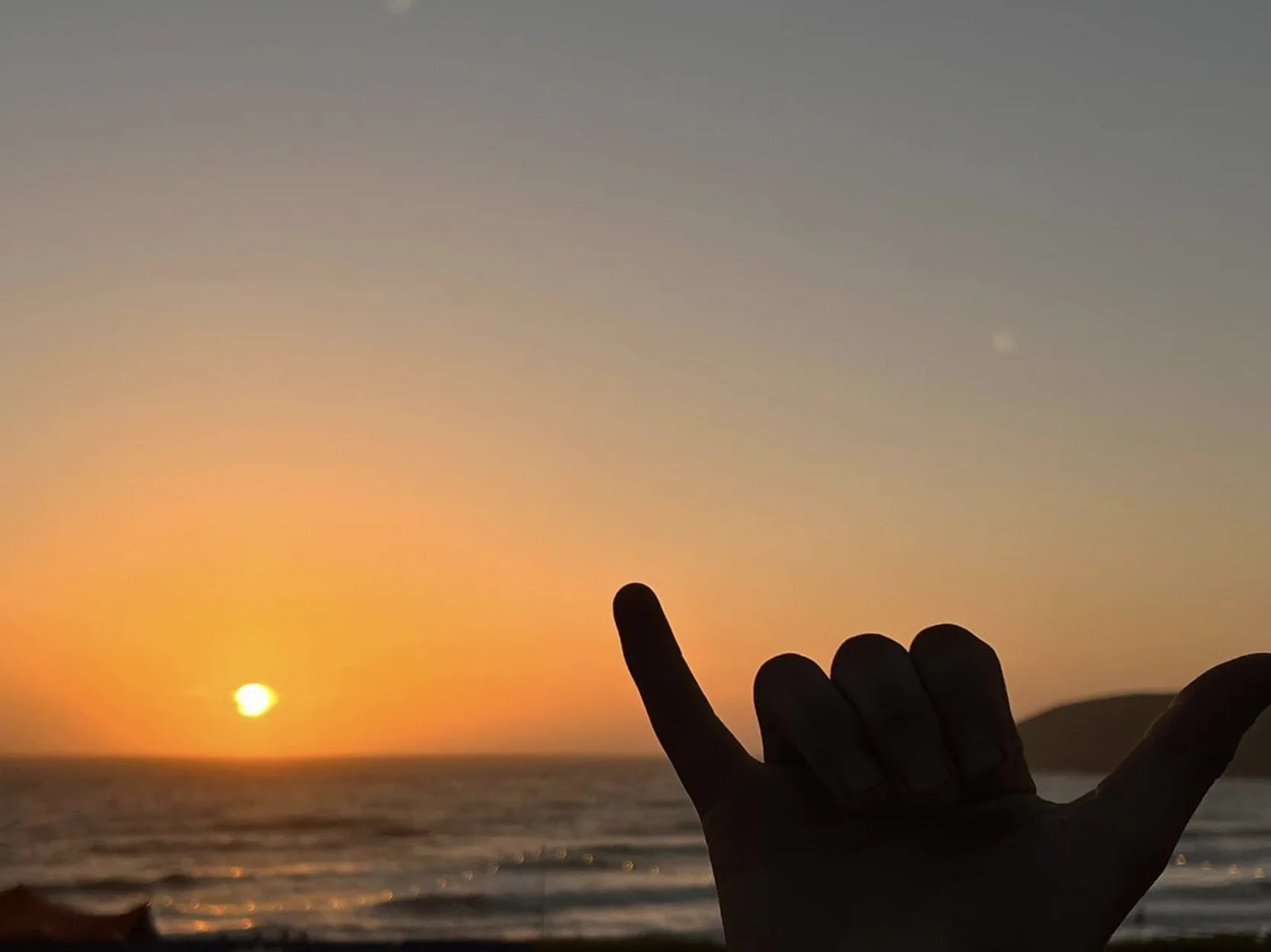
Image credit: Charlie Unsworth
The #beachoutofhours means taking advantage of the conditions whenever they’re right. Find your place to stay to watch the waves and act when the timing suits…
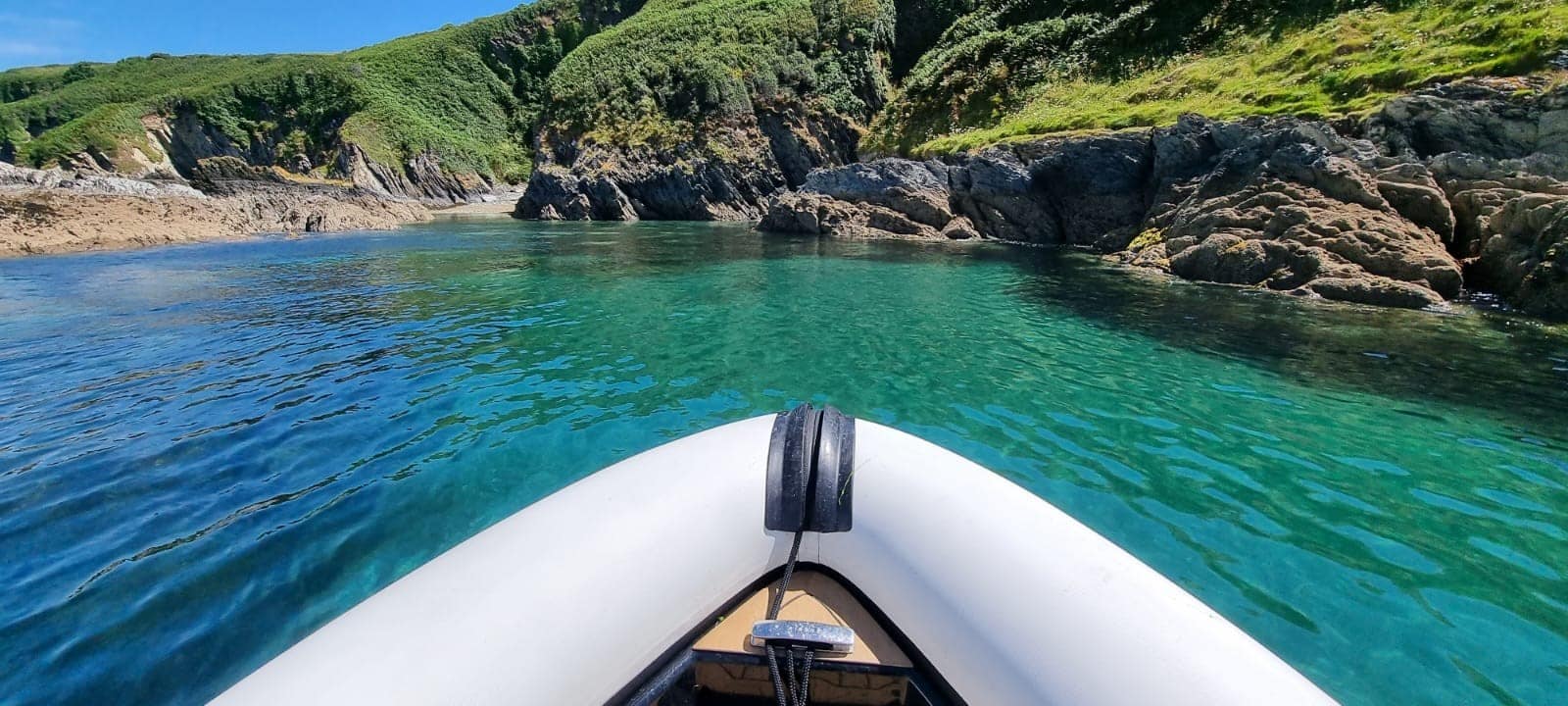
As the sun appears over the hills behind the beautiful port of Fowey, a small crowd of people gather to watch the launch of the stunning Rib, Meraud Atlantek, at Caffa Mill. One Atlantek are getting ready to collect the day’s guests from Albert Quay with a day of adventuring and exploration awaiting the family of four who discovered this luxury charter company having met them at Henley Regatta!
What started as a lunch booking at Sam’s on the Beach in Polkerris has turned into much more.
Visiting Cornwall for a romantic adventure? Check out our romantic cottages.

The guests are welcomed by the operations director and skipper of One Atlantek, Tim. As they listen to their safety brief with a fresh coffee in their hands, The brand new 8 metre Ribeye A811 gently bobs against the pontoon. Lifejackets are handed out and the guests climb aboard. Bags are stowed and before they know it, this lucky family are headed out of Fowey in the bright sunshine ready to start their adventure.
Discover coastal charm at our holiday cottages in Fowey, South Cornwall, with Beach Retreats.
Turning to the left out of the harbour mouth they soon arrive at Lantic Bay. This secluded beach has turquoise water and is a good trek to access it by land. The anchor is dropped and a morning swim is the next priority. Watched by a local Seal who is sunning himself on a rock.
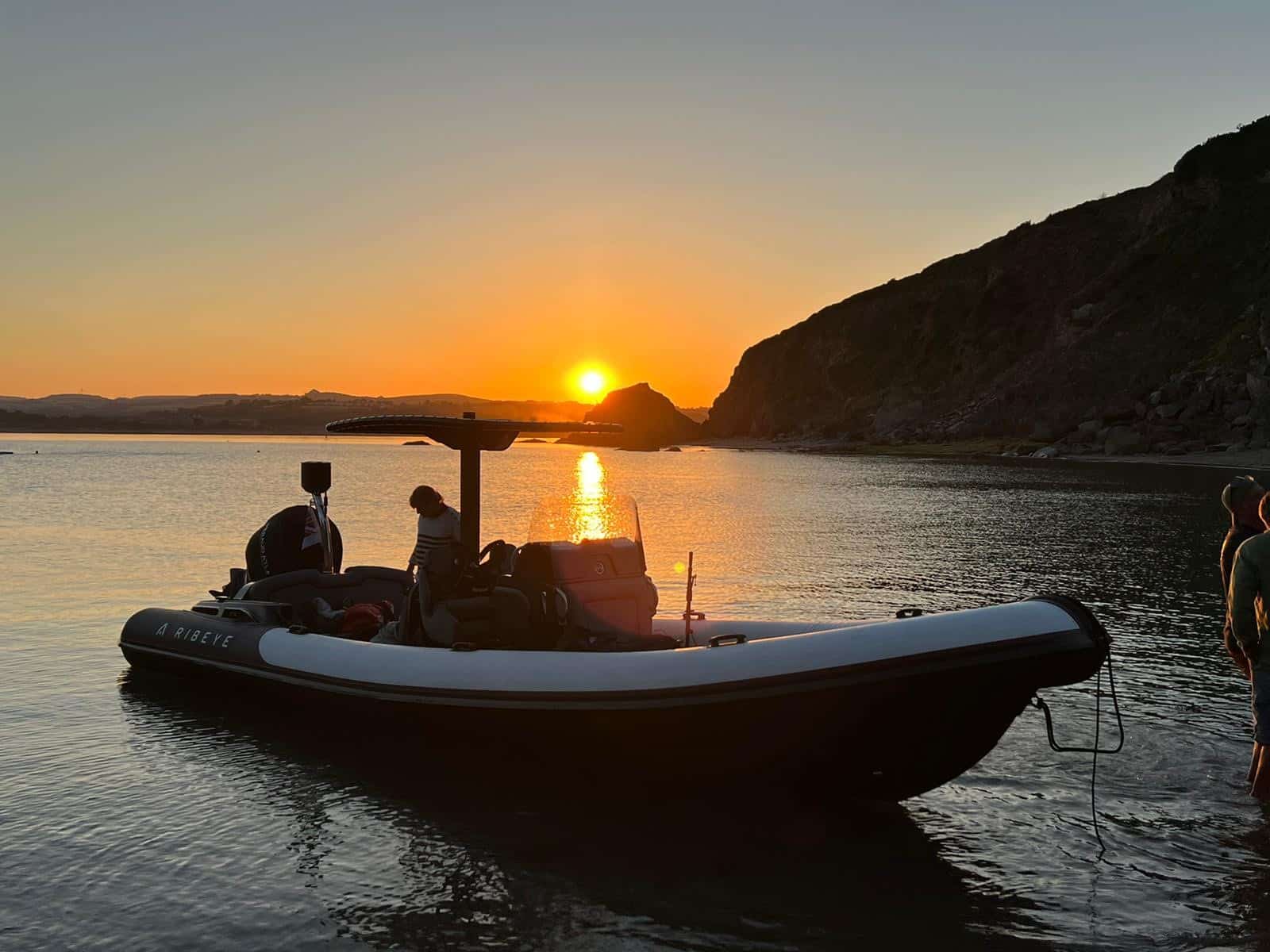
Everyone takes turns jumping off the boat and even the kids are dropping comments about how wonderful this place is.
After 45 minutes it’s time to really up the stakes for this group. Tim has spotted dolphins off in the distance and as the group dry themselves off, they are suddenly surrounded by at least a hundred of these majestic creatures. Three of the pod decide that the bow wave is the place to be and the guests are treated to a twenty-minute lesson in what playing in the water really looks like.
As quickly as they arrived, the dolphins are gone and Meraud Atlantek and her passengers are now in the middle of St Austell Bay looking back at the Cornish Alps in the distance.
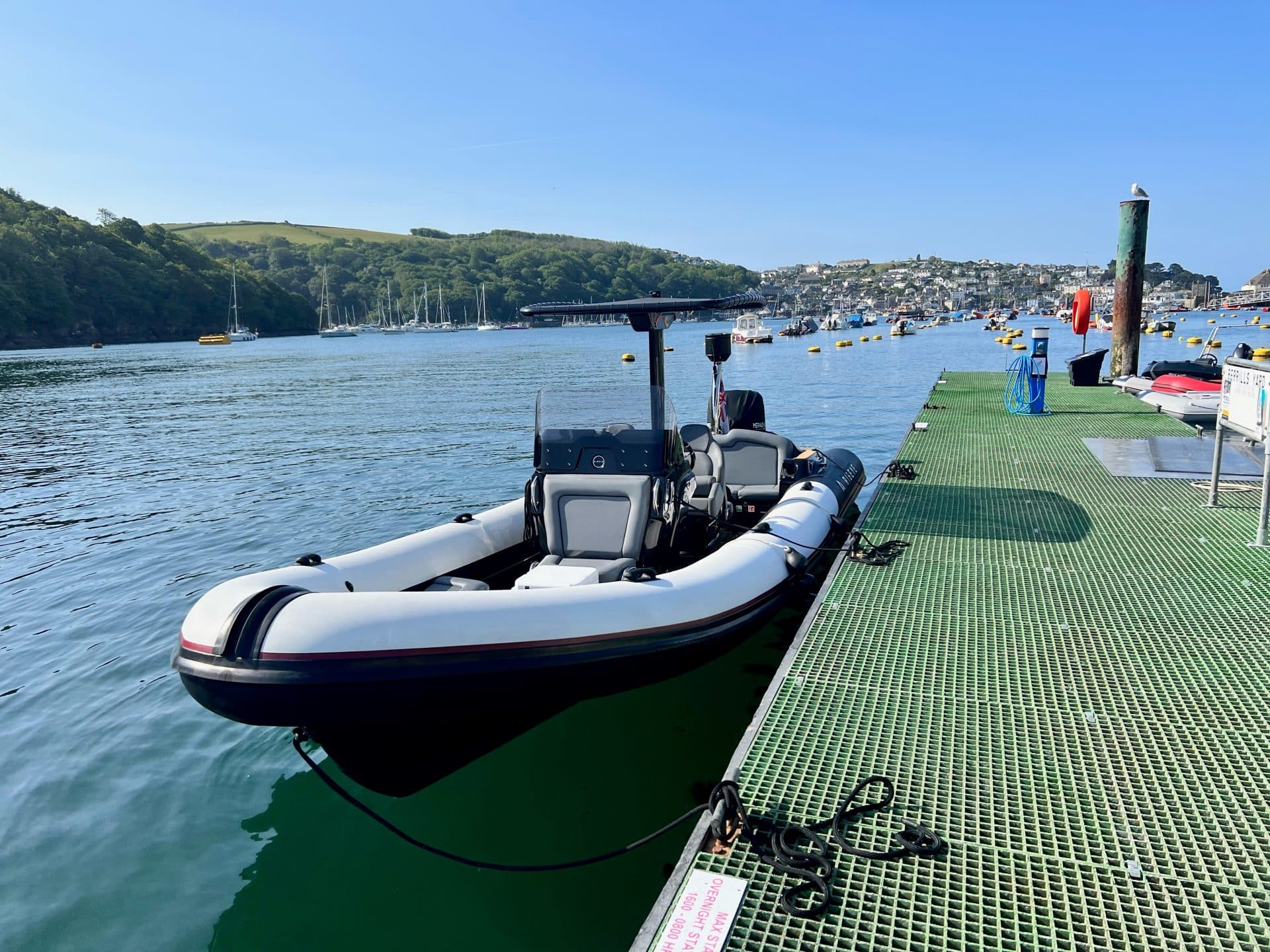
With the rising tide, the beaches at Silver Mines are the place to be. With no access from the coastal path, these are as close to a private beach as it’s possible to get and the snorkelling is fantastic.
With time flying by, It’s off to Polkerris to be dropped off at Sam’s. Meraud sits waiting just off the beach and with full bellies and big smiles, it’s time to be whisked around Gribben Head and back to Albert Quay where it all began.
One Atlantek are a small local company with some big ambitions. Created in 2022 by Tim Hogg, One Atlantek deliver a truly unique hospitality experience on board their beautiful Rib, Meraud Atlantek. Half Day (4 hours), Day (6 hours) and Extended day (10 hours) charters are available. Have a talk with Tim about creating your perfect day.
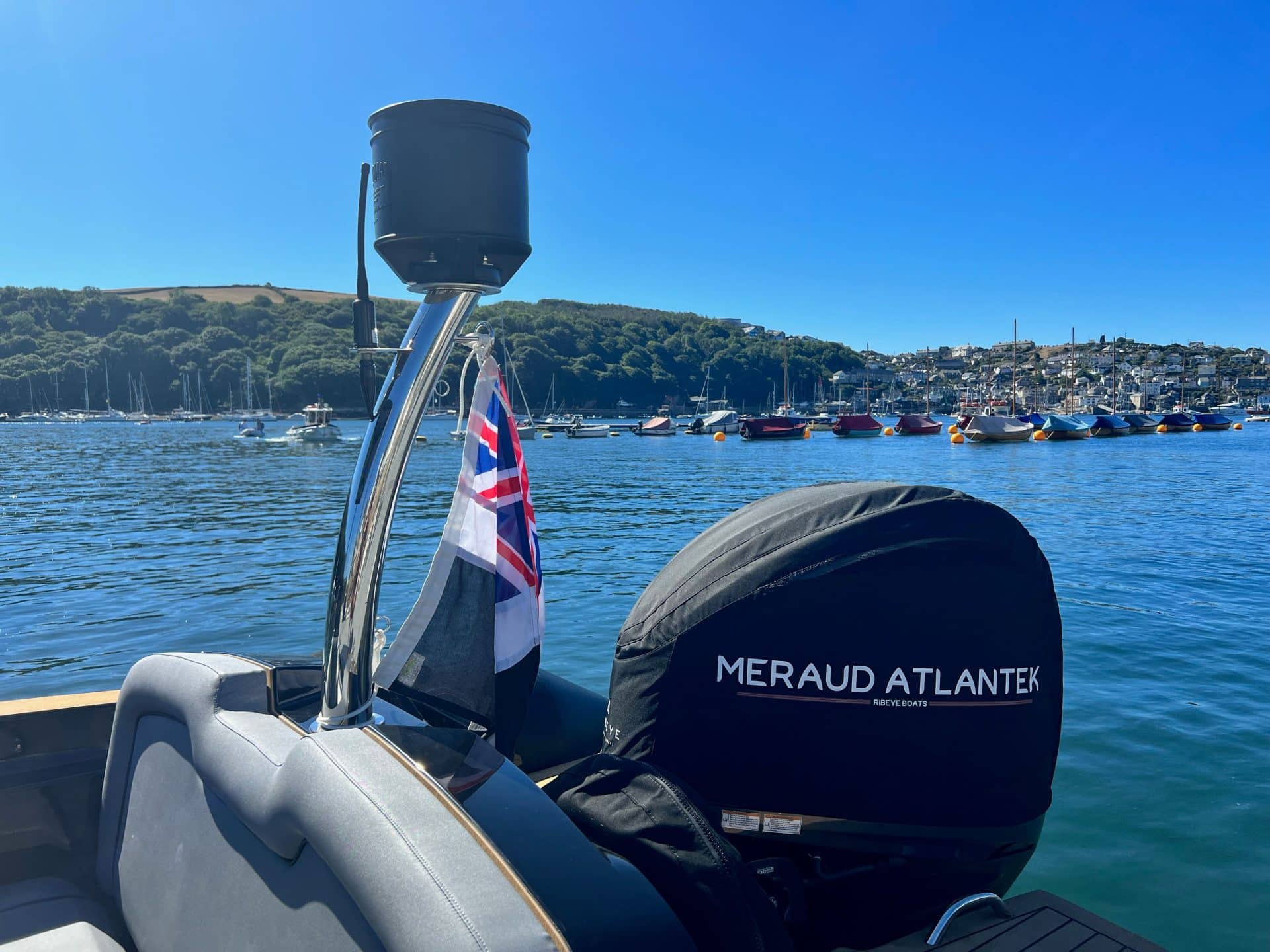
Find out more and book your luxury charter today, the perfect experience during your self-catered stay
Read our blog on the best things to do in the sea in every season!
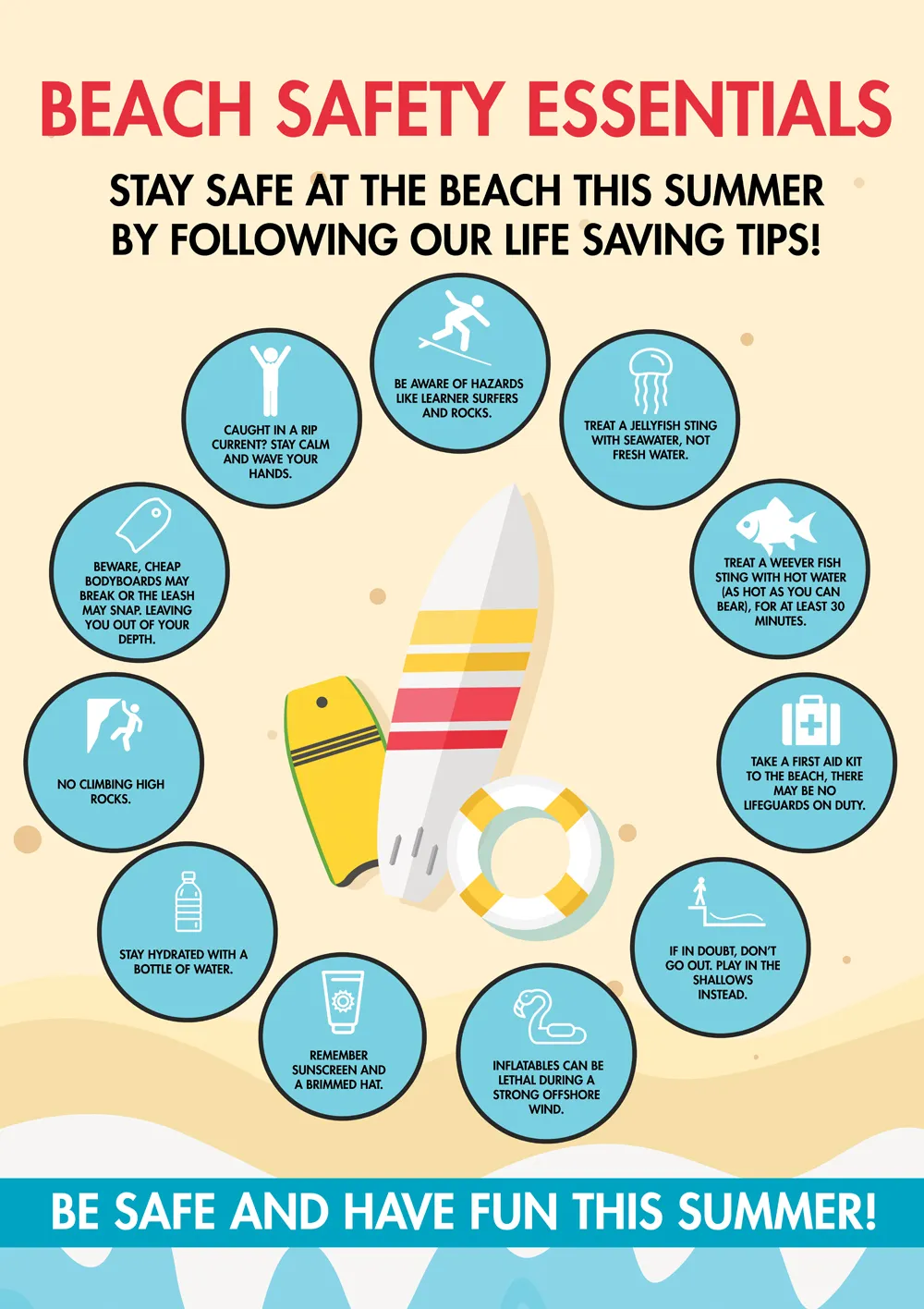
Here’s what you need to know if you’re planning a trip to the seaside…
Want to stay in a luxury holiday house with a view of the sea? Check out our cottages with sea views.
We hope you’re excited for your stay by the sea. While Cornwall is generally a safe place, each year there are accidents on our coastlines.
To ensure this doesn’t happen to you during your time with Beach Retreats, Newquay Activity Centre have produced some beach safety guidelines for you and your family to follow. Their instructors are fully trained lifeguards and work closely with the RNLI.
Save the image below to your phone and share with your loved ones ahead of your holiday to Cornwall.
Stay next to the sea with our other holiday lets in Perranporth!
You may see a flag with a red stripe on top and a yellow stripe underneath. There will be two of these red and yellow flags on the beach, and these mark out the area that it is safe to swim between. This area will be covered by lifeguards.
Mark Kelly is the Beach Lifeguard Trainer and Assessor at Newquay Activity Centre and says:
“The beaches are busy, and we’ve experienced a big swell recently that has already sadly caused fatalities and rescues. We urge surfers and swimmers to be aware, check the weather, tide and forecast.
For small children, there is also fun to be had in the rockpools and paddling in the shallows. We really hope that the RNLI are able to fully patrol the beaches soon, but we want people to understand how dangerous the sea can be and to stay safe at the beach”.
Discover more safety insights from the RNLI & stay safe at the beach with essential knowledge of natural signs at sea.
If you’d like to participate in a safe ocean activity this summer under the watchful eye of a trained lifeguard, or you would like to train as a lifeguard, please contact newquayactivitycentre.co.uk
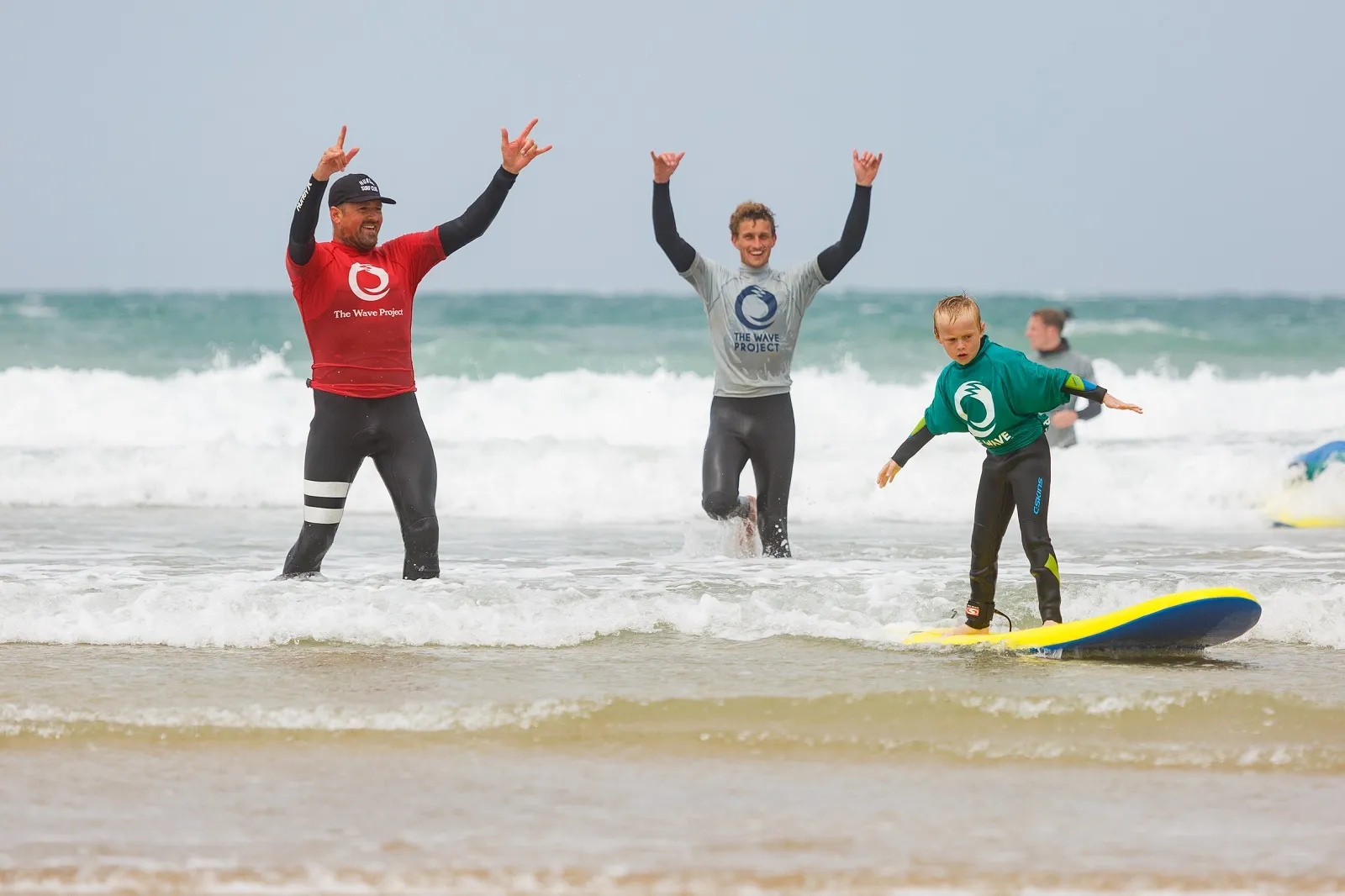
We’re proud to announce that we’ve recently become a sponsor of The Wave Project, a nationally-reaching surf therapy charity which was founded in Cornwall.
Our monthly donation will support projects in the South West, and allow the team to continuously respond to situations quickly and efficiently, ensuring that young people have help and support when they need it most.
This can include anything from paying for transport to and from the sessions, funding one to one adaptive surfing lessons, and waiving the Surf Therapy referral fee for young people who might otherwise fall through the gaps. Read more about the fantastic work The Wave Project does below.

With projects across Cornwall, but also extending across the UK, The Wave Project is a lifeline to young people across the country.
Supporting children and young people who experience a range of physical and mental health issues, social deprivation, or social isolation, the Wave Project facilitates a range of activities, including year-long surf therapy courses which aim to help participants build self-esteem, develop resilience, and make friends.
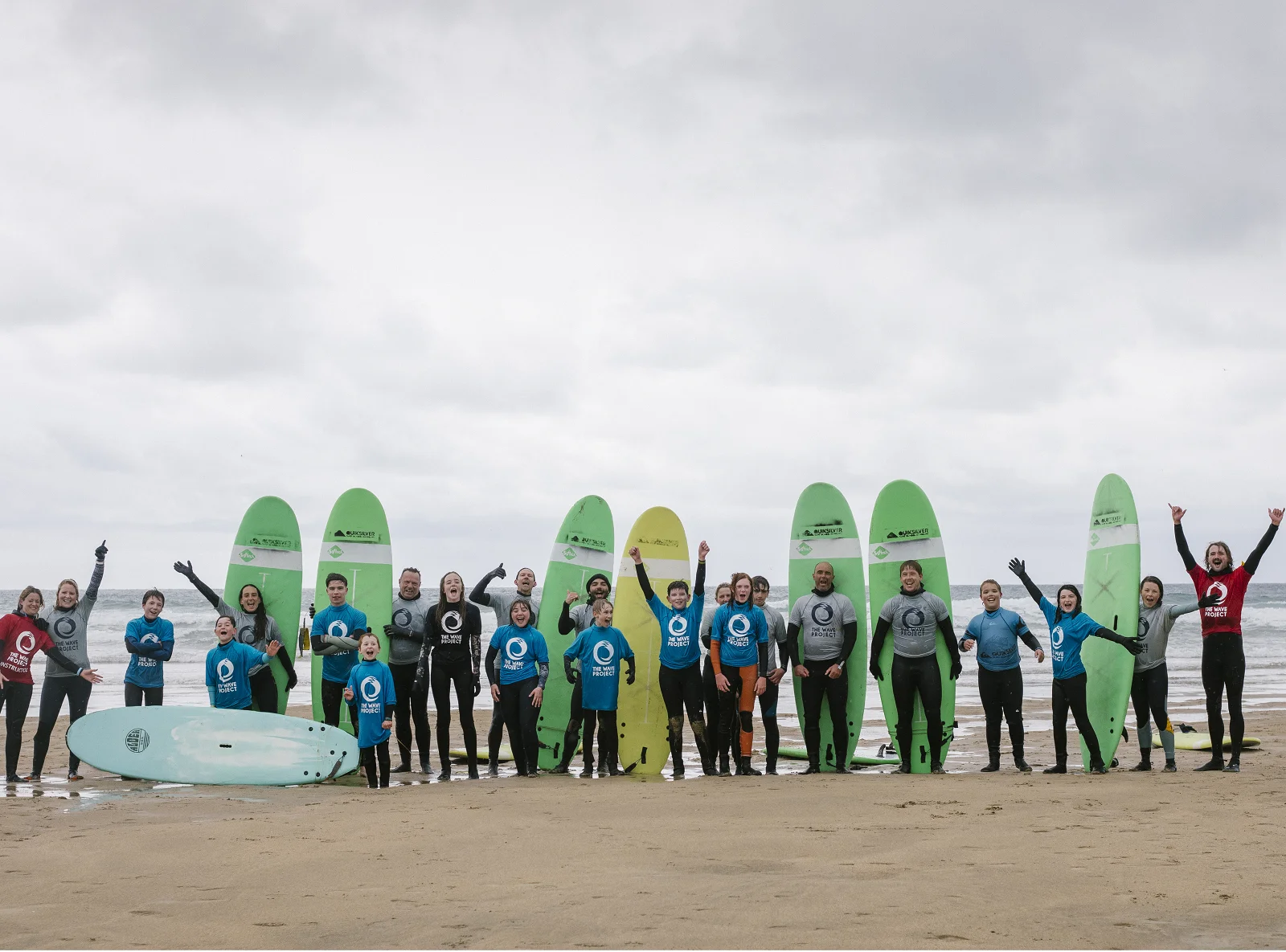
A Surf Club is in place for those who have participated in the Surf Therapy courses, along with a Beach Therapy Programme which blends surf therapy and education to help pupils who have found engaging in school life a challenge to get more inspired and motivated to learn.
Firm believers that surfing is for everyone, the Wave Project has also acquired the necessary skills, training and specialist equipment to deliver safe and enjoyable surf lessons for those with physical disabilities from its Adaptive Surfing Hub in Croyde, North Devon. Later this summer, they will also start offering adaptive surf sessions from Watergate Bay in Cornwall.
The nationally award-winning surf therapy courses are free of charge for participants and their families. This means that the charity wholly relies on donations from its supporters to fund the activities, which are run by a team of dedicated volunteers.
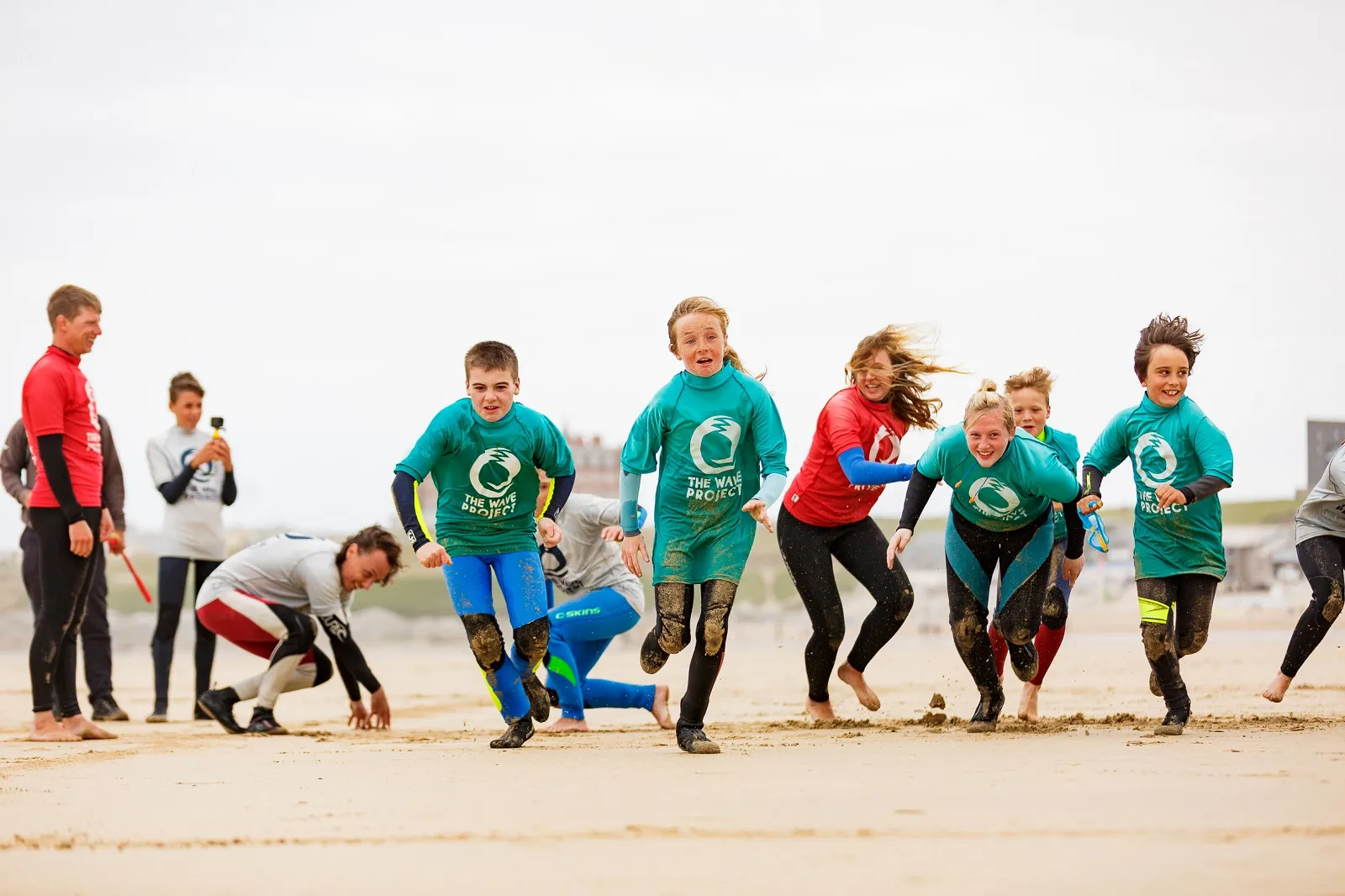
Newquay project co-ordinator Fred Andrews said: “We’re immensely grateful to supporters like Beach Retreats for their donations, which allow us to run the activities our communities across the UK have become so reliant on over the last ten years.”
Watch a video on the brilliant work The Wave Project is doing to support children and young people below.
With over 240 properties on Cornwall’s coast, the beach is in our DNA, so it feels only natural that we support a longstanding Cornwall-founded charity like The Wave Project, helping them to deliver lifechanging therapy and courses to young people in need.
Andy, our MD said: “We’re proud of our coastal heritage and want to give back to the community, supporting young people’s physical and mental health, and driving awareness of water safety.
“We’re very excited to see how this partnership unfolds, and we can’t wait for our teams to get stuck into volunteering for this fantastic charity.”
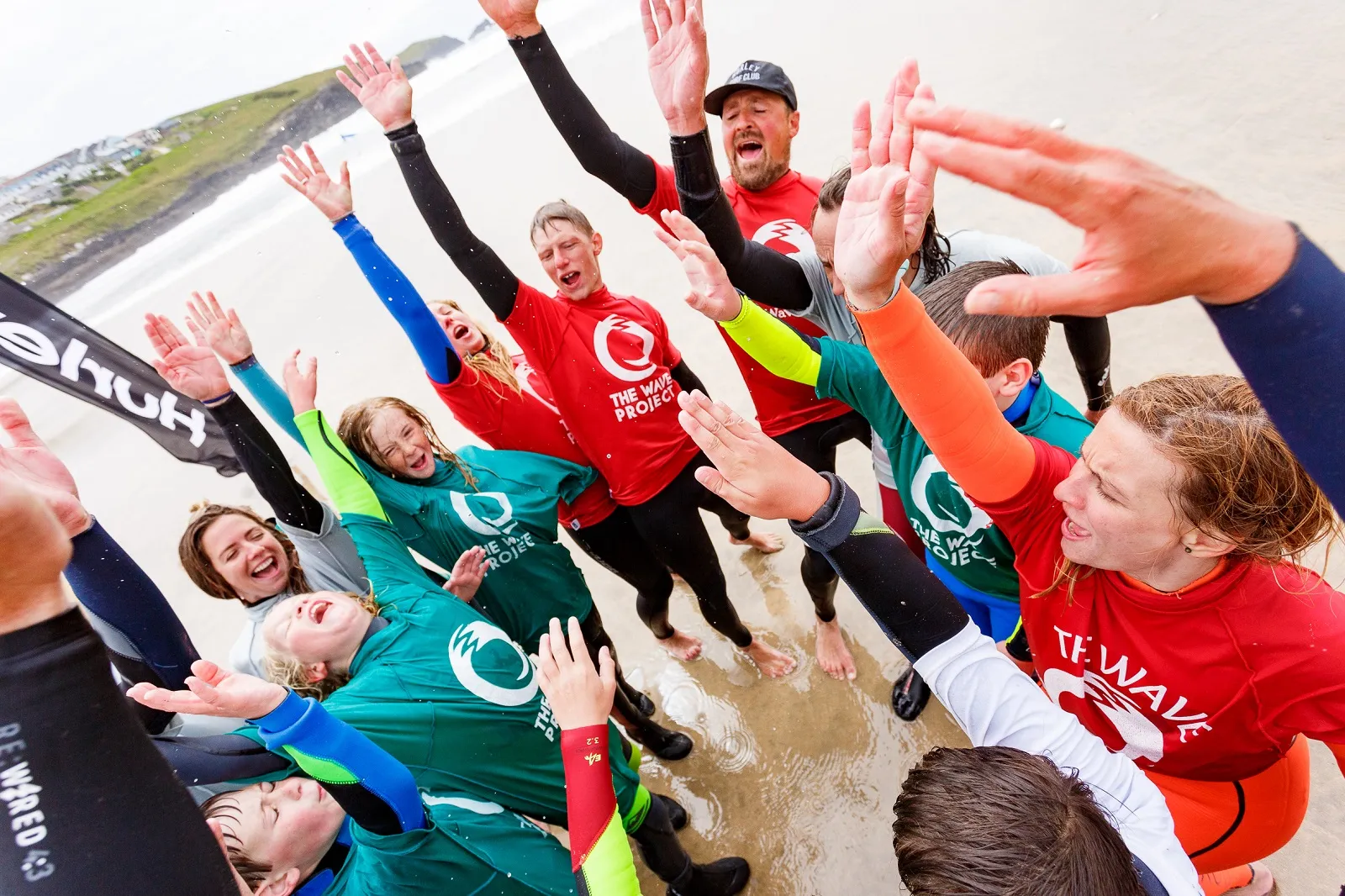
For more information about the work the Wave Project is doing across Cornwall and the UK, visit their website.
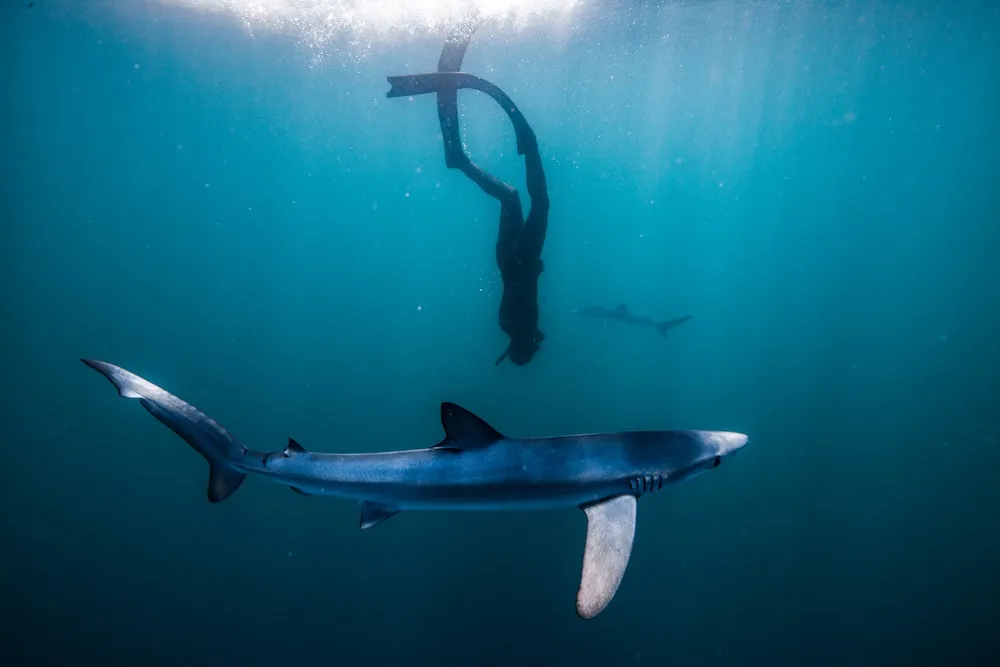
Whether you’re exploring on a single breath, or stealthily seeking your supper, taking your ocean activity beneath the surface is the ultimate in water time contradictions – giving in to the calm surrender of the deep even when your pulse is jumping…
Visiting Cornwall for a workcation? Have a look at our holiday lets perfect for extended stays and working.
Breathless discoveries

Credit: Aquacity
Hold your nerve, take a breath, dive. Freediving – diving beneath the surface on a single breath – is not a sport for the faint hearted. With no scuba or air tank to rely on and only your instinct as your guide, it’s at the more demanding end of the watersports spectrum.
“Freediving has the reputation of being an extreme sport,” says Georgina Miller from freediving outfit Aquacity in Porthkerris, “but really, it’s all about relaxing and exploring your relationship to the sea. It’s actually vital that you relax while challenging yourself and pushing your body to its limit.”
A competitive free diver and instructor, Georgina explains that the breathing techniques freediving uses are useful for staying calm in any situation. But if you are brave enough to venture under the waves, the sport is even more of a stress buster, says Georgina. “Being underwater, for most people, allows some peace in an otherwise hectic world,” she continues, “It’s quiet and you’re in such a different environment – you can lose a sense of yourself and relax into it peacefully. But this only comes with patience and practice at being calm and present.”
Check out what Falmouth has to offer by staying in one of our bespoke retreats in Falmouth.
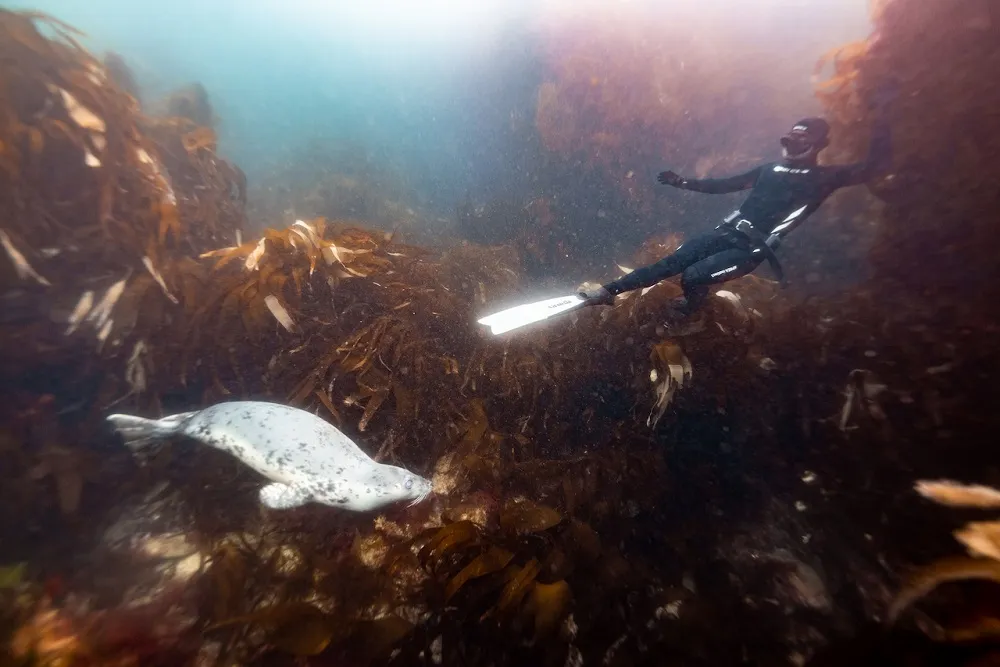
Credit: Aquacity
There’s no doubt that competitive freediving brings more of a heightened edge to the discipline. Freedivers can regularly swim down to depths of more than 100 metres on a single breath. It’s a very specialist, highly skilled world, where technique and ability juxtapose with mindfulness and calm. Freediving is not without its risks so it’s important to never dive alone and let qualified instructors lead you safely into the deep.
But even at the leisure pursuit end of the sport, there are thrills to be found. Though more often than not, they come from the interactions that happen under the water, rather than the depths reached.
In addition to dolphins and seals, Georgina regularly sees lobsters and spider crabs hiding in the cracks, magnificent shoals of pollock, wrasse and mackerel, and majestic basking sharks drifting through the depths.
“We had a training session recently where a pod of dolphins came to check us out – they looked like they felt sorry for us not being able to swim too well!” she concludes. “When you’re being checked out by marine mammals there definitely seems to be a connection, they’re curious, even playful. It’s pretty incredible.”
Steady stealth
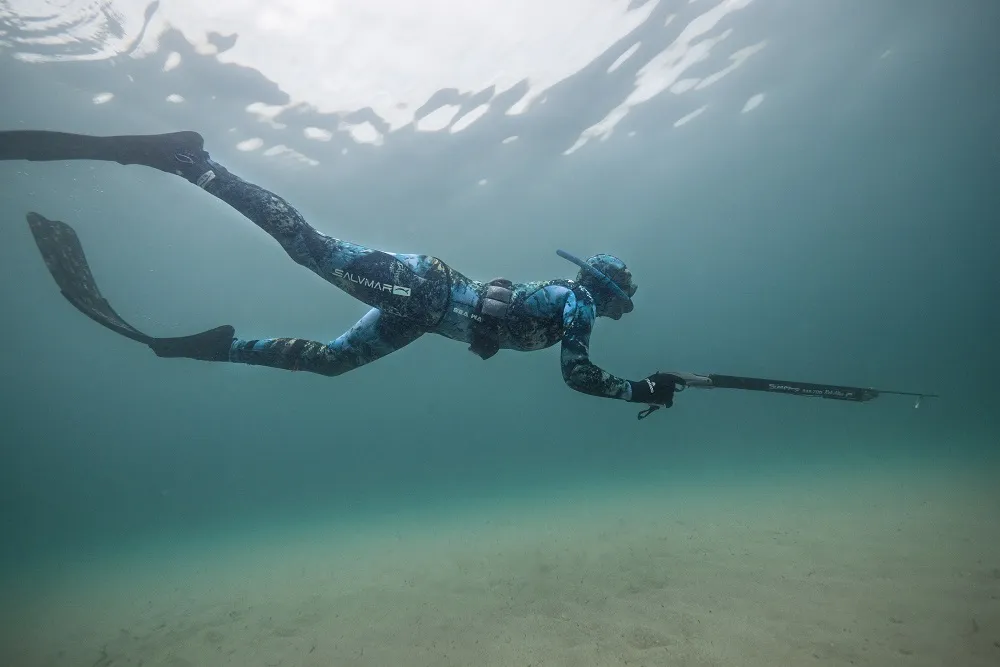
Credit: Chris Moakes
Add the pursuit and excitement of the hunt and catch into your deep water time and you’re taking it up a gear. Spear fishing, freediving’s faster-paced cousin, is one of the most sustainable ways to fish and requires, skill, dexterity, speed and patience, all in one.
This balance of quick action and absolute calm is something Laith Dajani from Spearfishing UK knows all too well, as he explains, of a recent dive. “On one breath I went down to 13 metres, to fish. It took roughly 17 seconds to get to the bottom. I found and speared a 9lb Pollock in seven seconds, and then came back up in another 17 seconds,” he says. The whole experience was just 41 seconds in total. But with that level of excursion and concentration, diving to and rising from the ocean floor all in the smallest window of time, staying relaxed is an epic task in itself.
For Laith, it’s the unique mix of control and quick thinking that gives spearfishing its appeal. “You want to remain as calm as possible. If you’re stressed, the fish will be stressed, and they won’t be comfortable around you,” he continues. “It’s all about stealth and tactics. Sometimes fish are curious, so making grunting noises can attract them, or throwing up sand can bring them in. Alternatively, stalking works just as well, hiding or moving as slowly as possible through seaweed, not making a sound.”
But when the time comes to fire the speargun, you have to think fast. “You need to be in the moment with no hesitation,” he says, “otherwise the fish will scatter and you’ll be swimming to the surface empty-handed.”
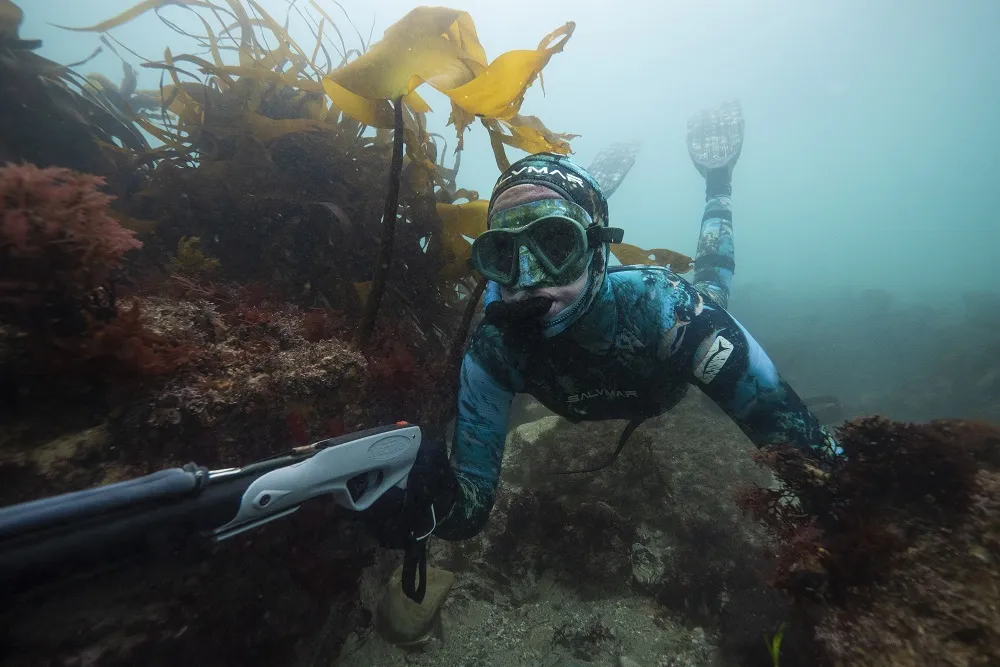
Credit: Chris Moakes
If the speargun isn’t for you, you can hunt for lobster, brown crabs, scallops and mussels by hand. For Laith, catching a 9lb lobster off Cornwall’s south coast was an unbeatable experience. “Lobsters like to hole up and can be found as shallow as one metre. You just need to look in as many holes as possible and eventually you’ll stumble across one.”
From combing the sea floor for shellfish to plunging into the deep, underwater ocean time is all about finding the right pace for you and working with the ocean. As Georgina says about freediving, “it’s not about an application of your will over the water, you have to consider the environment and work with it.” And what a magical environment the Cornish coastline has to offer, shoreline, surface or deep. Now, who’s for a dip?
Read about adventures of every pace: on the shoreline or on the surface too…
Experience transformational moments with Beach Retreats as you explore new horizons and enrich your soul.
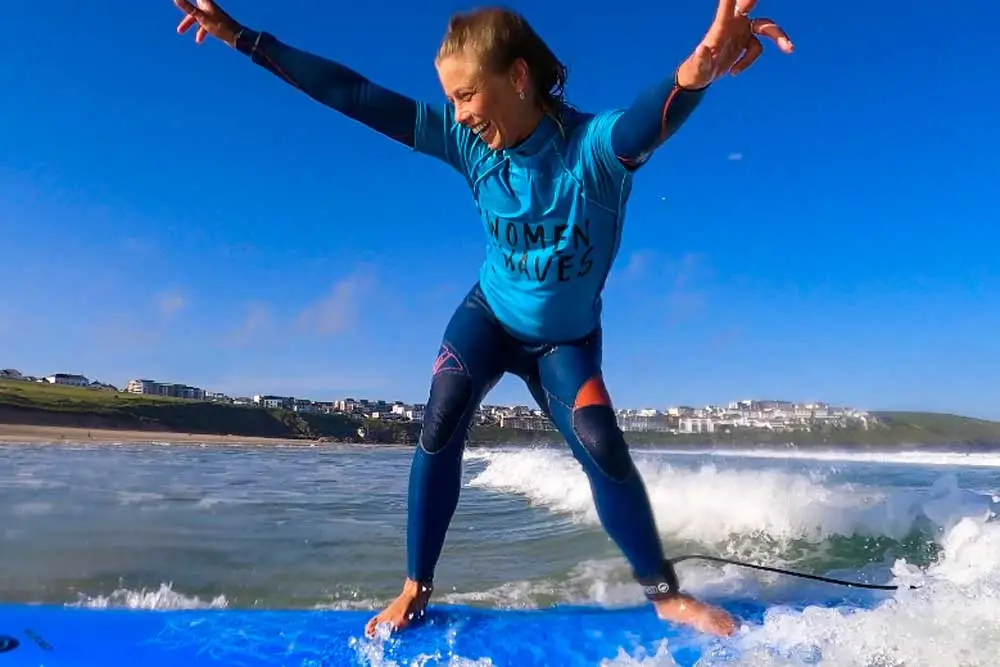
Finally, the time has come. As April has arrived and spring is blooming, we are also slowly regaining our freedoms. This means that we can once again explore and enjoy Cornwall in all its glory.
Thinking of visiting in the February half term, check out what activities we recommend trying in February.
Yet despite the irresistible call of the ocean and the sunshine, this year will once again be different. We’ve put together this handy guide with some ideas on how to make the most of Cornwall this spring, whilst avoiding the crowds and embracing the new normal.
Fancy staying in a holiday retreat with a swimming pool? Check out our cottages with a swimming pool for a relaxing getaway.
The expanse and variety of Cornwall’s beaches means that there is enough sea to go around for everyone, and what better way to enjoy the spacious outdoors than getting in amongst the waves? If you don’t feel super confident hitting the surf alone, Cornwall’s Women and Waves Society run group classes and trips to make surfing fun and accessible for all women.

If surfing isn’t your thing, there are still plenty of ways to get a daily dose of H20 and enjoy Cornwall’s glittering oceans. Try taking a dip in a cove of your choice- there are plenty of popular spots to head to so you can ensure your swim is safe. Simply immerse yourself in the icy blue water, letting your body relax and restore as you leisurely float. Warning- it may take your breath away!
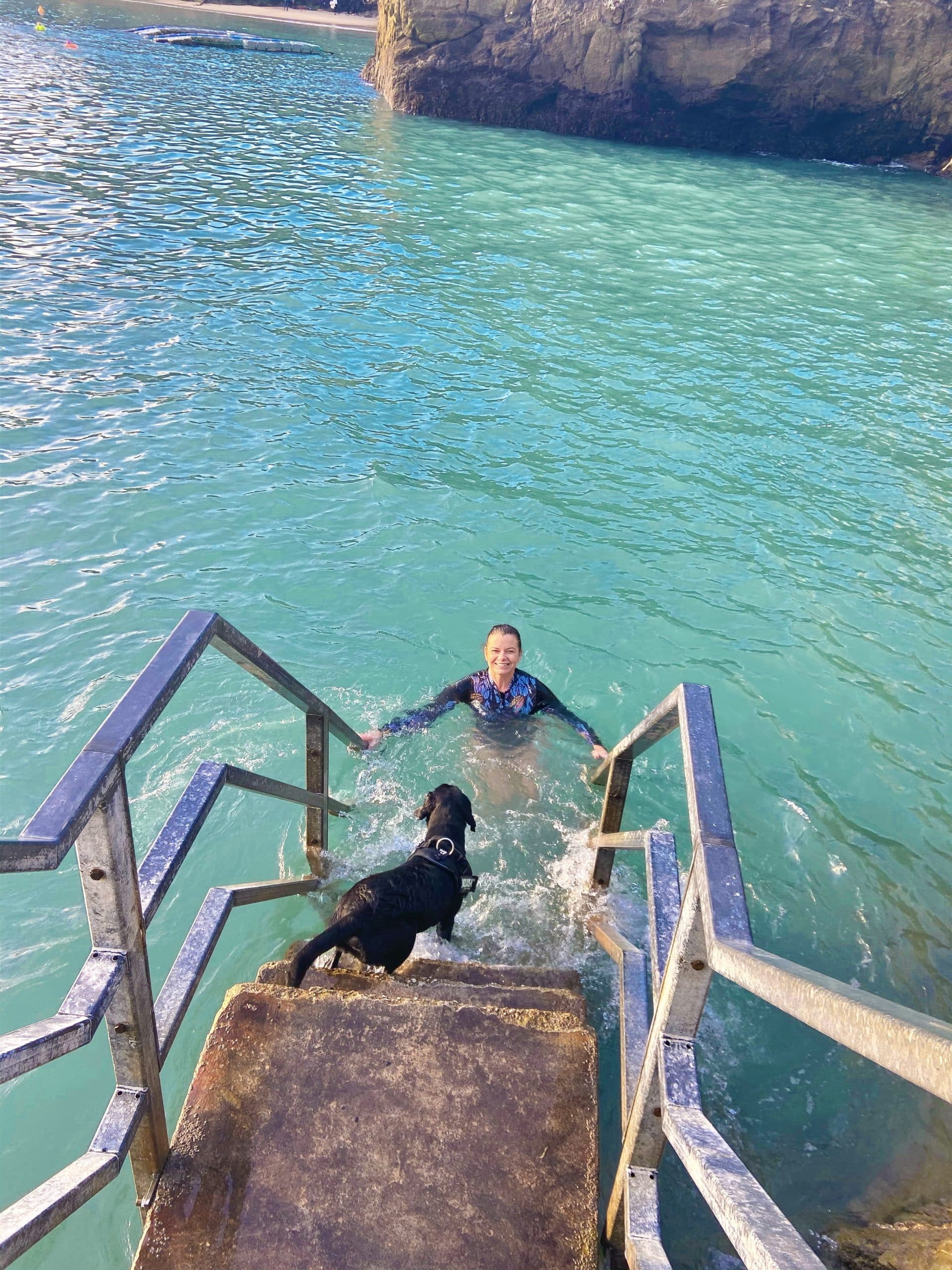
The beauty of Cornwall’s beaches means that in peak times, they can get very busy. If you’re looking to avoid the crowds this summer and carve out a more tranquil spot for yourself, why not try and hunt for a secret beach? Cornwall’s rugged coastline means that it is home to many hidden gems where you can soak up the sun in peace. Finding the perfect spot may take a bit of adventuring, but it is possible- start with the lesser-known treasures of Porth Joke beach in Crantock and Housel Bay in the Lizard.
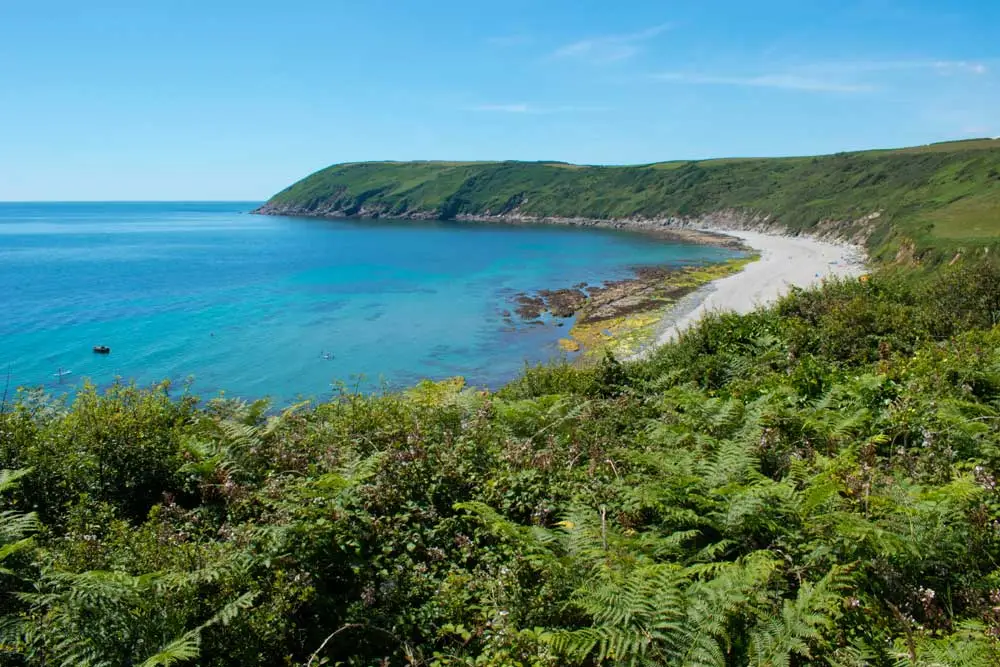
Where in Cornwall could you find more open space and picture-book scenery than along the many coastal paths that line the county? With fresh air a key to reducing the spread of Covid, fill your lungs and walk along miles of uninterrupted clifftops. Check out the South West Coast Path website for directions on how to access the UK’s longest and best-loved National Trail. This 630-mile-long path is walking distance from all our properties, so leave the car behind and stretch your legs across a section of this magnificent walk.
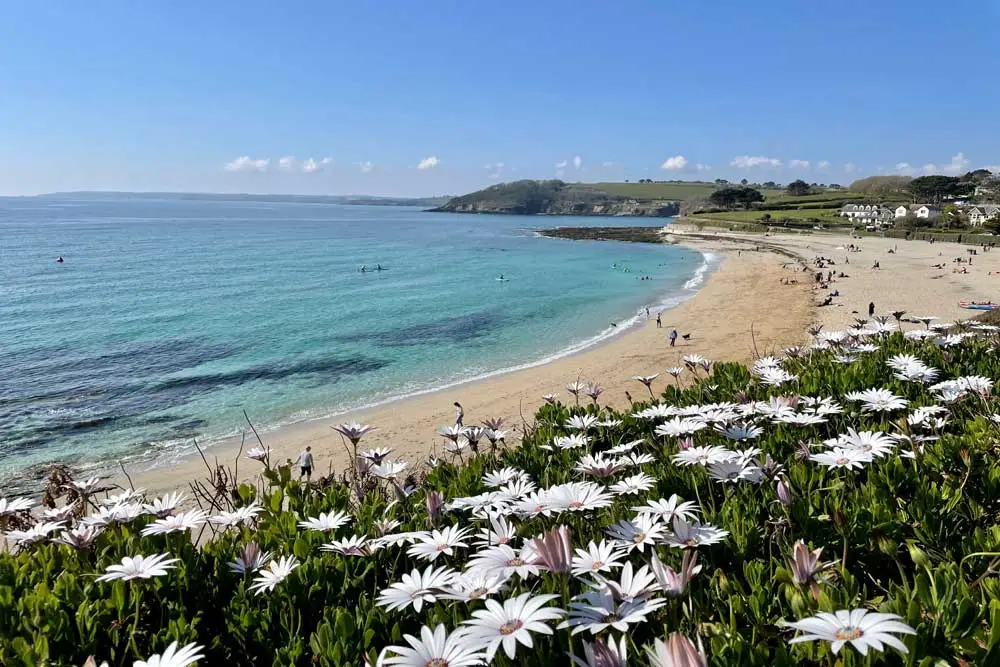
With dining in busy spots less of an option this year, bring the leisurely experience of dining out to an outdoor space with Dine with Iris’s personal pop-up picnics. She will supply you with a delicious seasonal grazing board, pillows and rugs, themed flowers, a Bluetooth speaker and much more. You don’t need to worry about setting up or packing it up, this is all taken care of. So, bring a few loved ones along and enjoy a Cornish picnic in style.
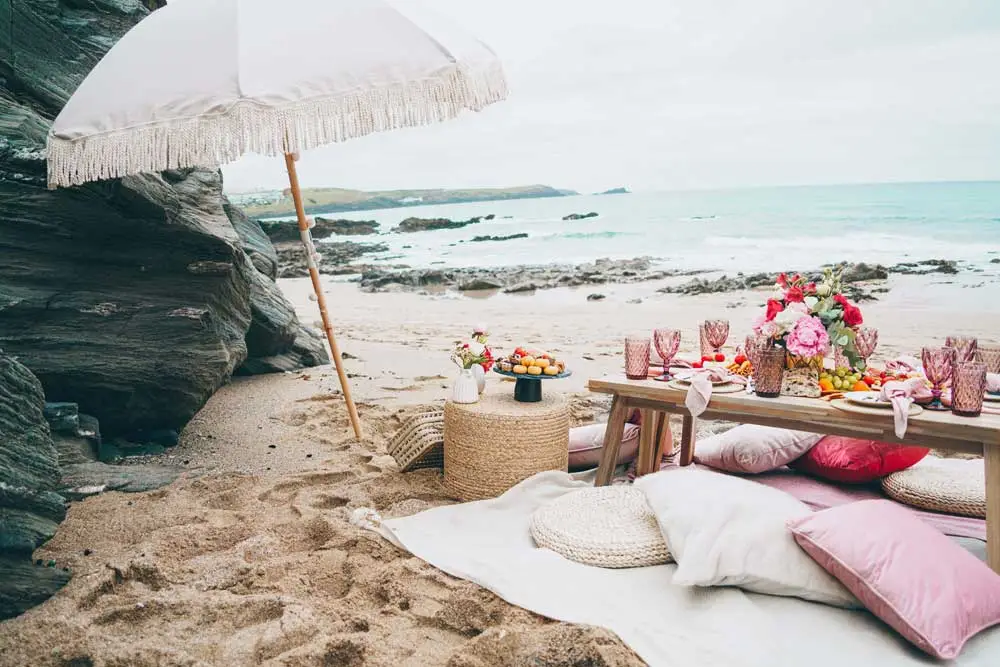
To fully embrace the more peaceful spring we will be having, away from large crowds, why not channel this energy into an activity devoted to tranquillity? Here in Cornwall, you will find many outdoor yoga groups, some offering beach sessions which will allow you to sync your breathing with the calming crash of the ocean waves. Check out Alicia Ray Wellbeing for private classes, or even just bring a mat and a calm mind and give it a go in a quiet corner of the beach.
Not only does it offer miles of untouched coastline, Cornwall is also home to some of the nation’s most exotic gardens, bursting with the colours and scents of summer. Many of these can be visited this spring abiding with social distancing regulations. Delve into the tropical terrain of Trebah gardens, where you will find acres of sweeping flowers, jungle-like trees and secret ponds, all leading towards a secluded and sunny beach at the bottom of the valley. Stray from the crowds and into the embrace of nature.
The best way to avoid the crowds is to get up before them. All of our properties are walking distance from the beach so you can easily stroll down first thing in the morning, where you can enjoy the quieter hours. Early in the morning, you will see the first golden rays of sunlight which shine beautifully onto the untouched sand- you will truly feel as though the beach belongs to just you. If you are more of a night owl than an early bird, head out at sunset time to soak up the more peaceful atmosphere of later in the day.
To enjoy a meal in your own space, why not head down to a secluded spot of the beach for a BBQ dinner? Many of Cornwall’s beaches allow private BBQ’s, so long as you leave no trace once you’re done. So, sit back and relax, with a sizzling burger and a bottle of something cold, as you dine al fresco. You can visit a nearby butcher or food store to source some fresh and organic ingredients to cook with. Just remember to bring a blanket to stay warm in the open air as the spring sun dips lower in the sky.
Cornwall is home to many great cycle trails, and these can be a fun way to stray from the beaten path and explore away from the crowds and the holiday traffic. The Camel Trail, which ranges from Padstow to Bodmin, offers an 18 mile stretch of scenery and fresh Cornish air. Whilst cycling along the historic disused railway line, you can stop off at some quieter spots along the way where you may catch a glimpse at some fascinating Cornish wildlife. For more experienced cyclists, why not stray from the path and explore the many little villages and country lanes which lead off from the trail?
Fancy staying in Padstow? Check out our luxury holiday lets in Padstow.